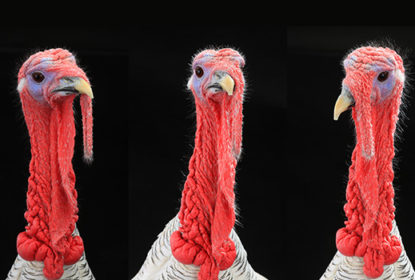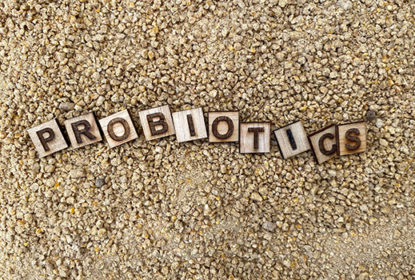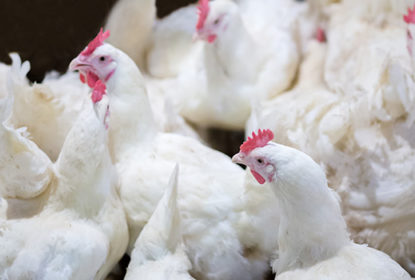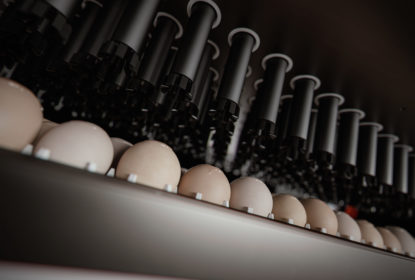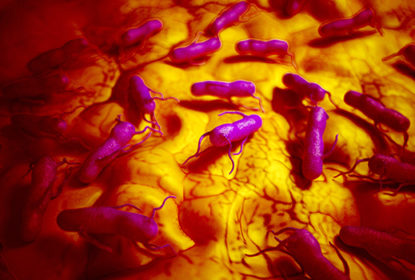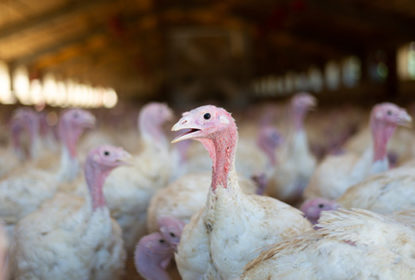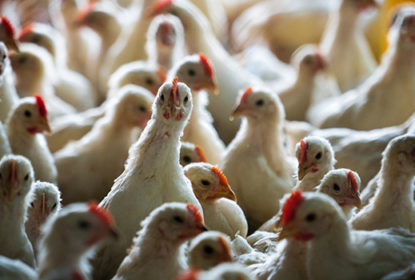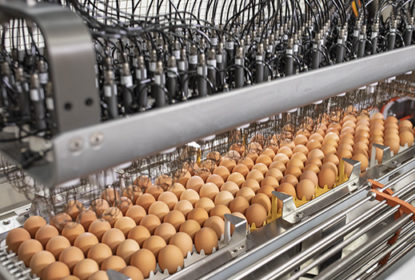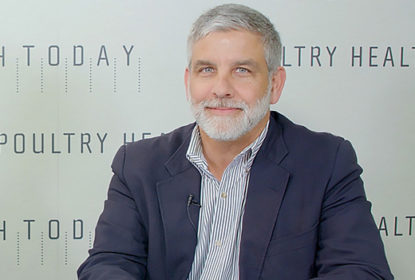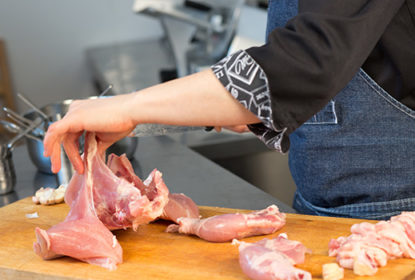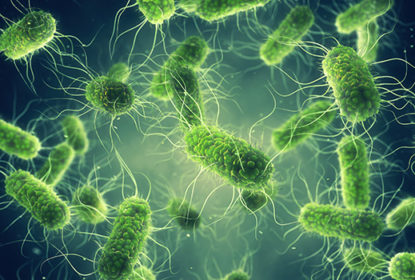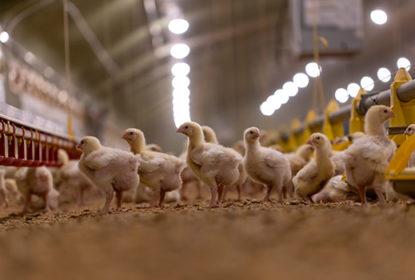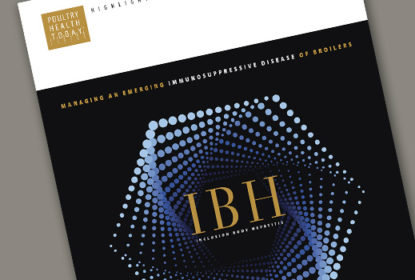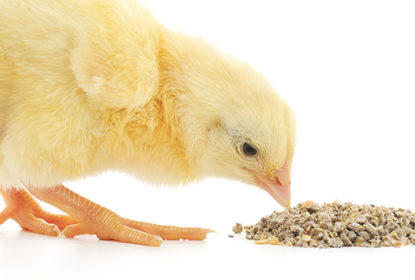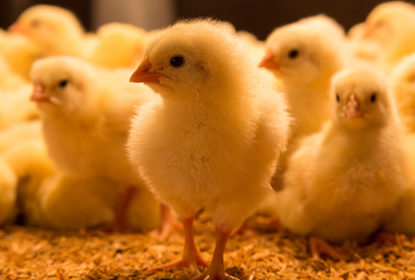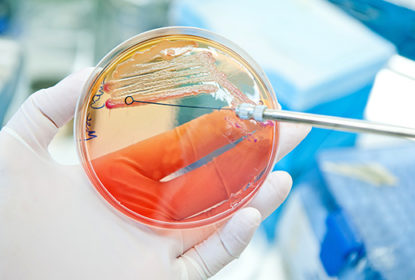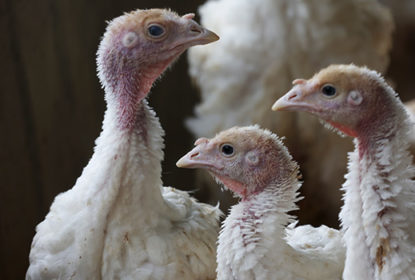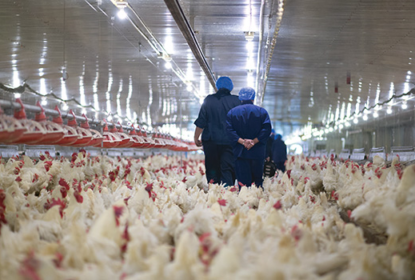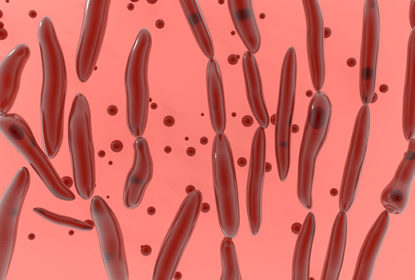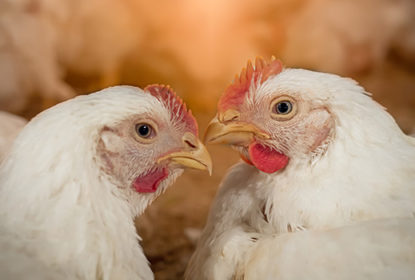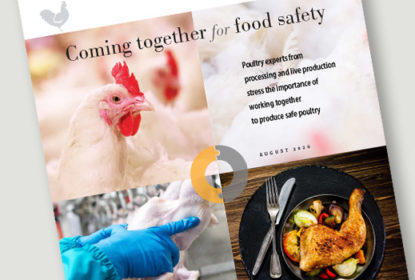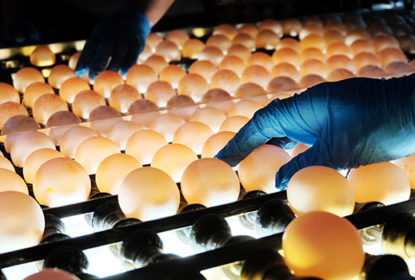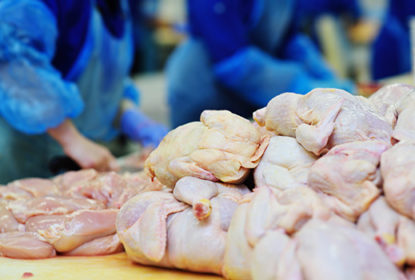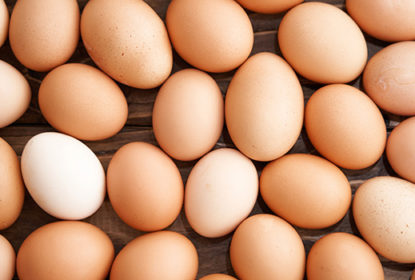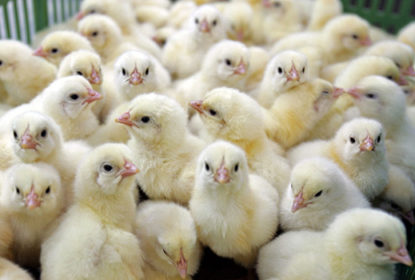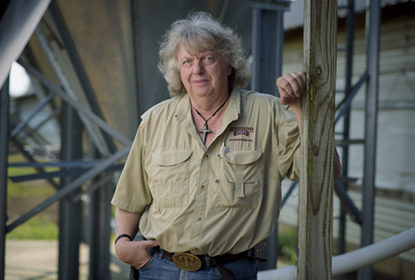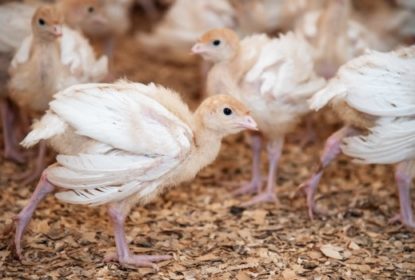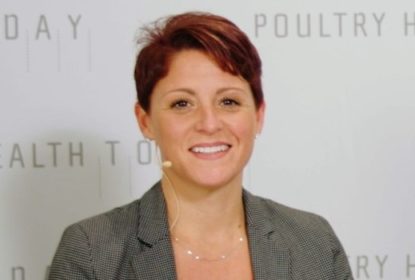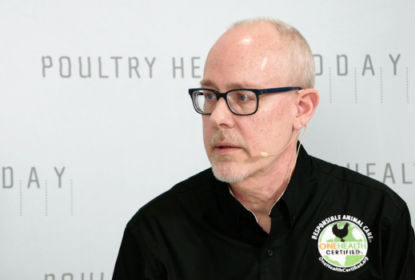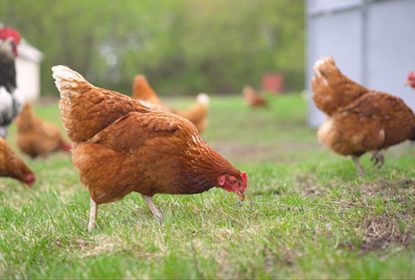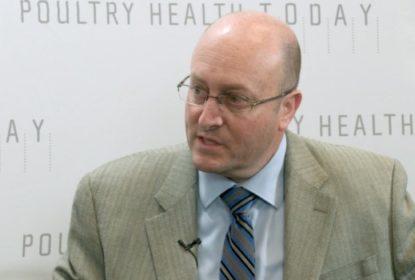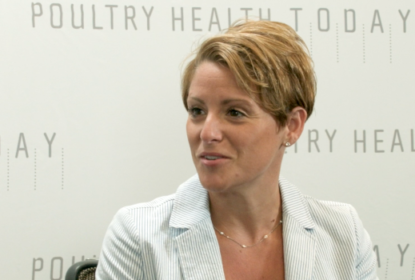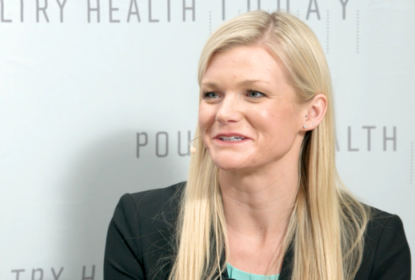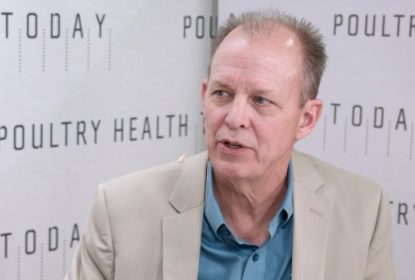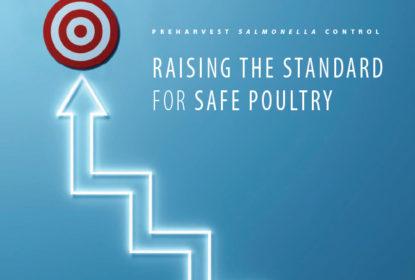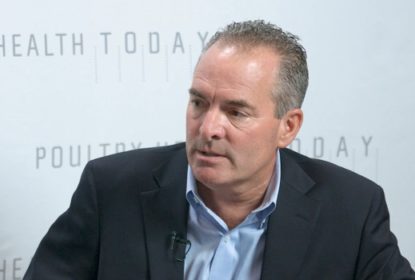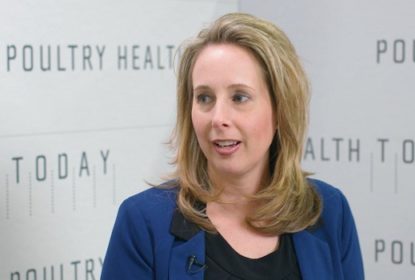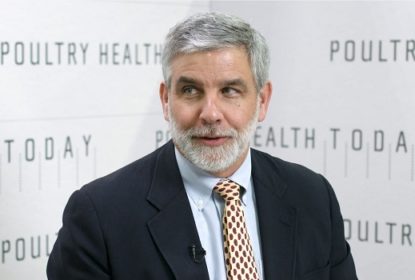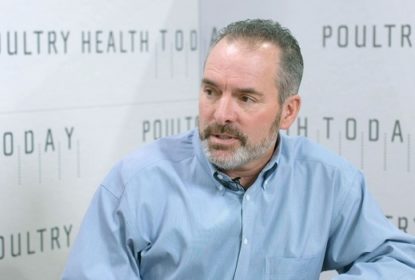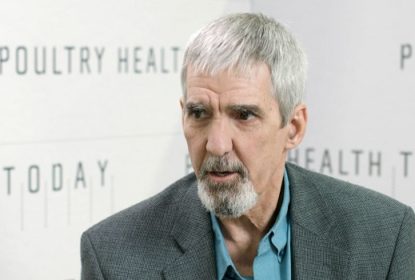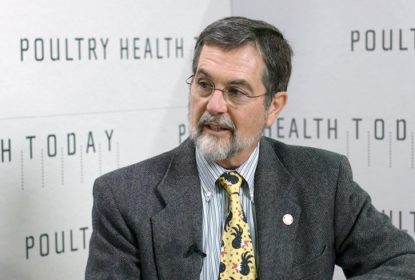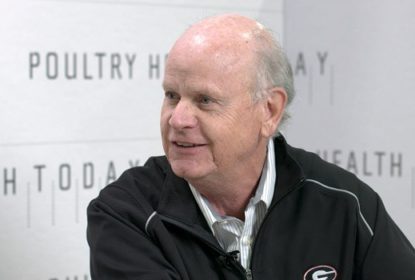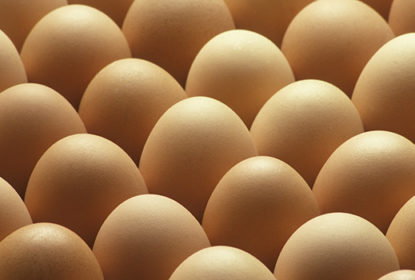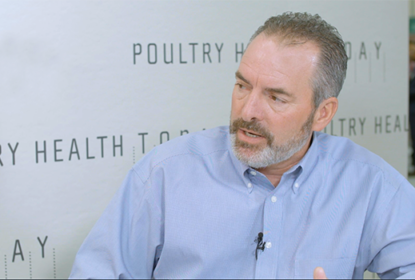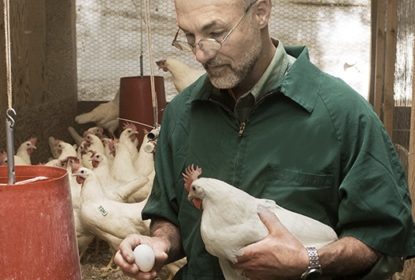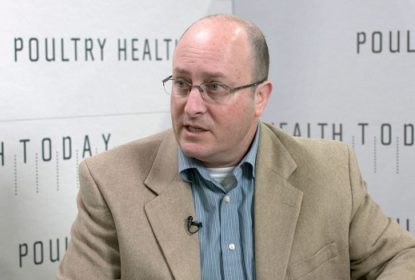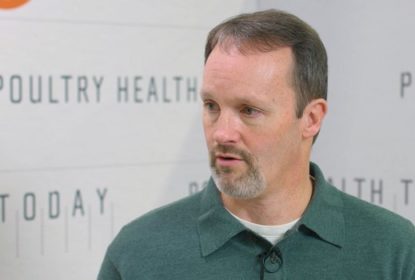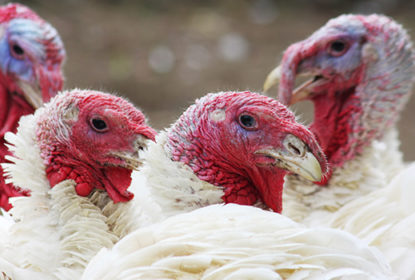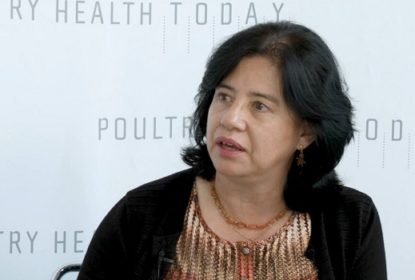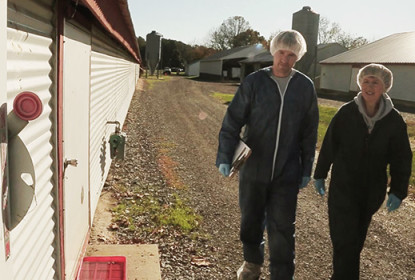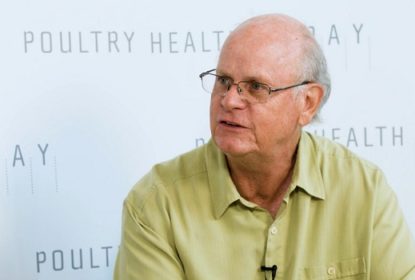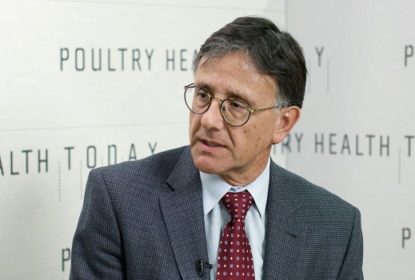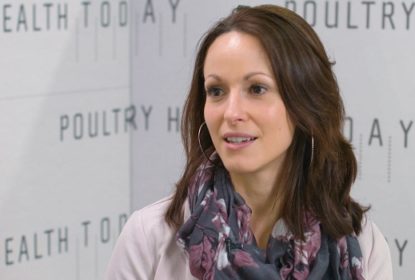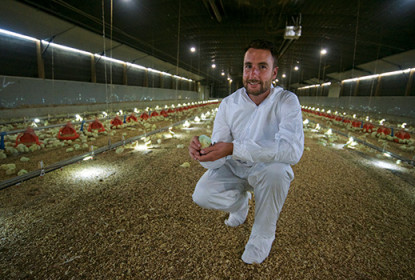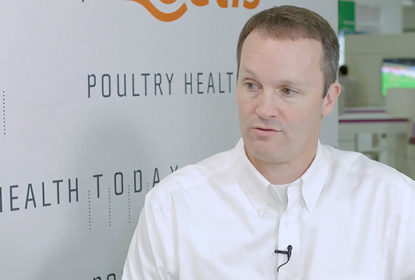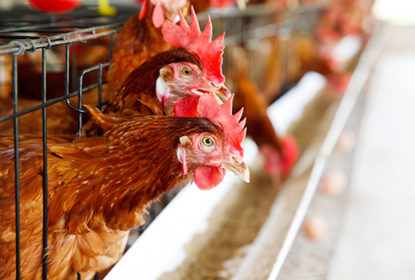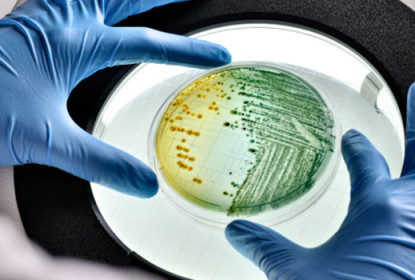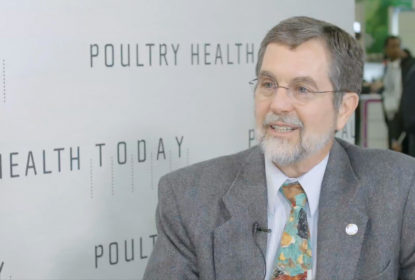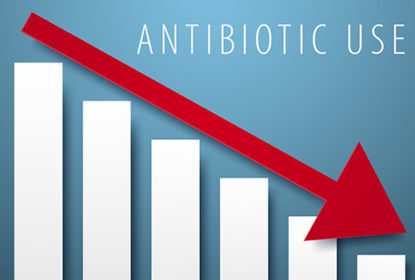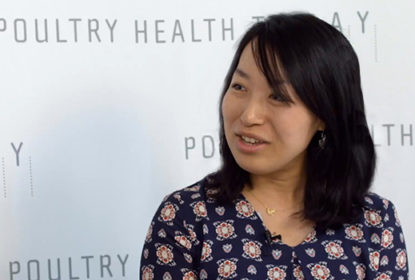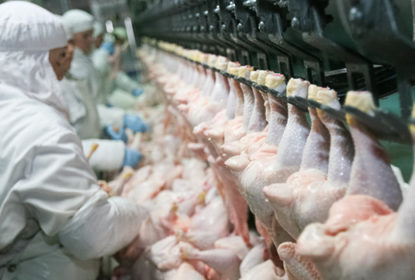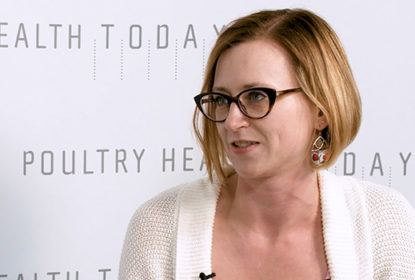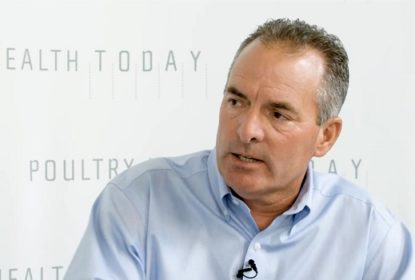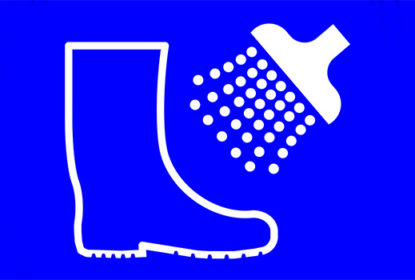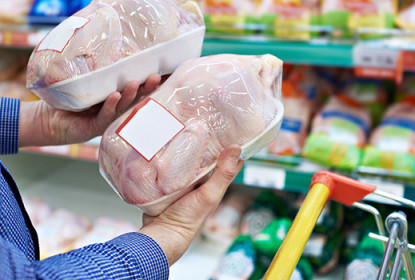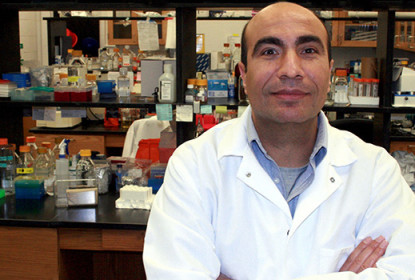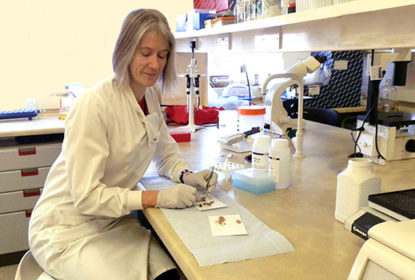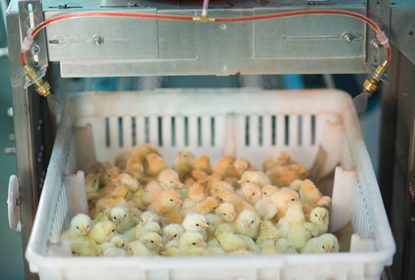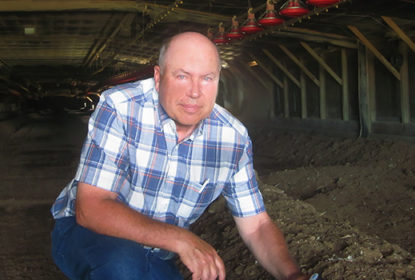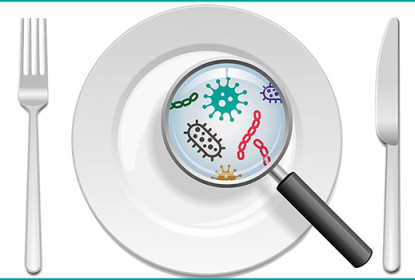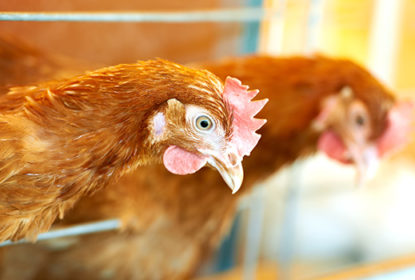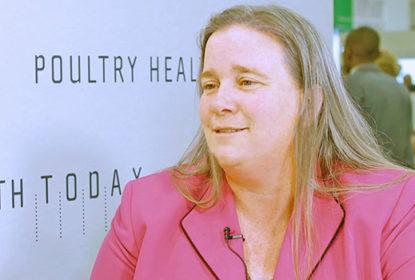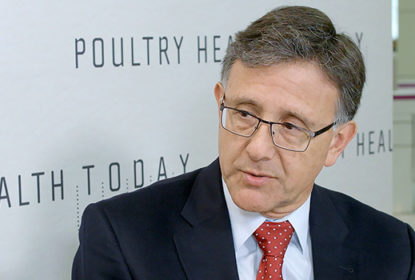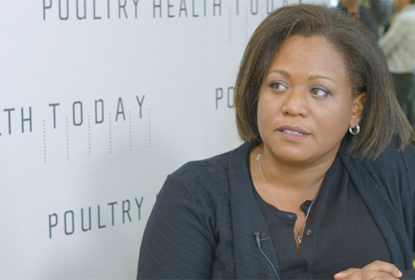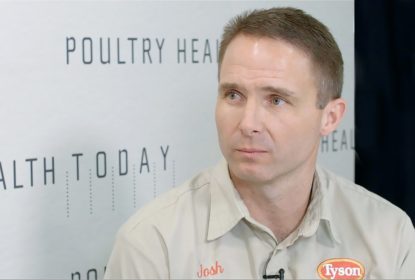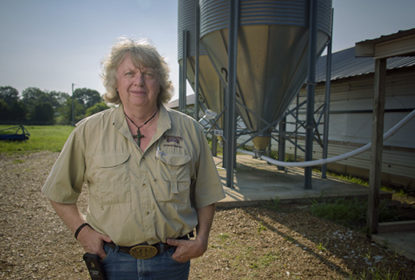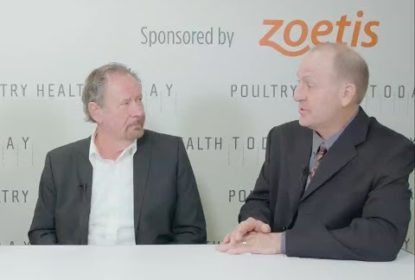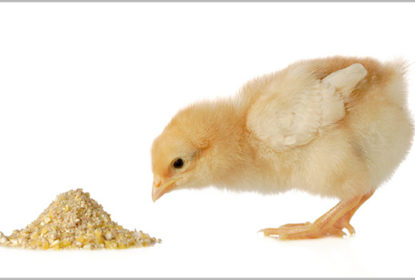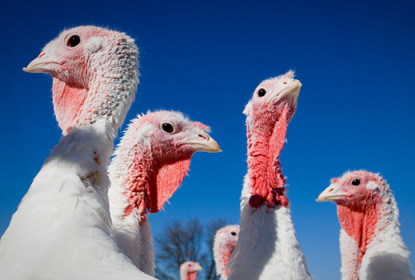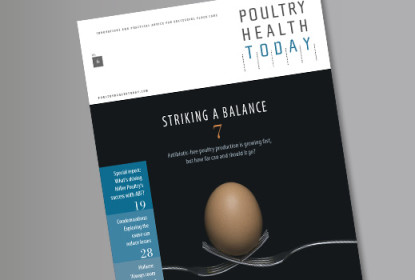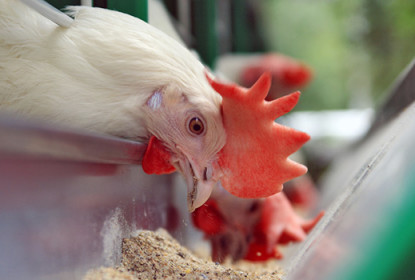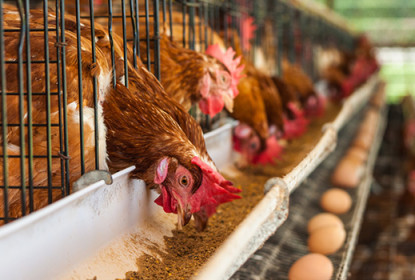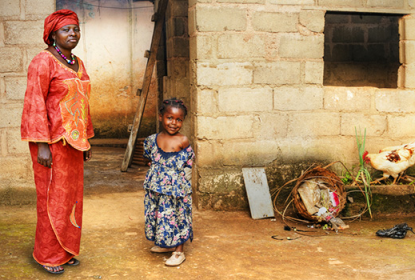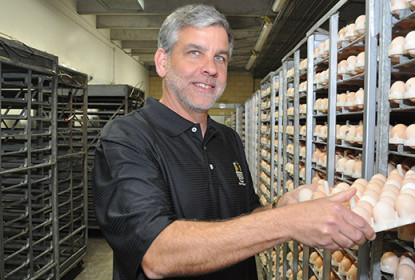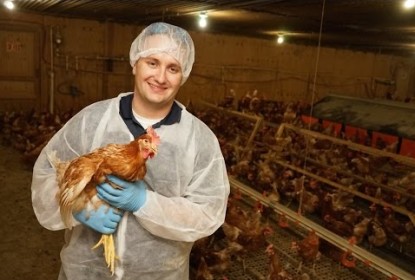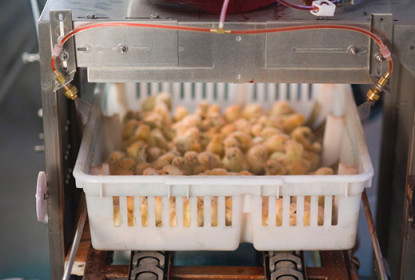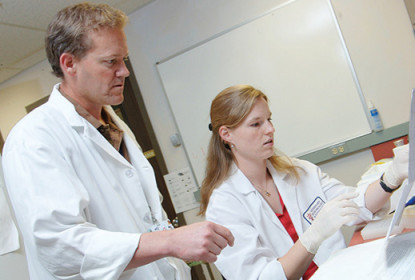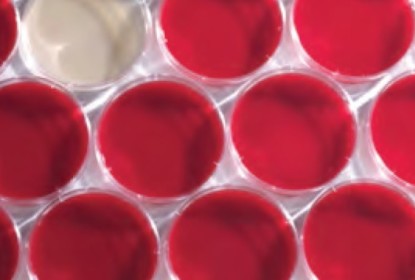Category Archive: Flock welfare, Global TOP NEWS, Infectious Diseases, PHT GLOBAL, PHT US, TOP NEWS
... Managing protozoal diseases in turkeys: There’s a lot we need to learn
Dec 27, 2022Jennifer GrullonComments Off on Managing protozoal diseases in turkeys: There’s a lot we need to learn
Three experts from research, production and industry share their experiences and offer insights for addressing protozoal diseases in turkeys.
Flock welfare, Global TOP NEWS, Infectious Diseases, Interviews, News, PHT GLOBAL, PHT US, Podcast, TOP NEWS, Videos
... Back-to-basics for managing health of cage-free pullets
Dec 26, 2022Jennifer GrullonComments Off on Back-to-basics for managing health of cage-free pullets
Poultry producers with cage-free pullet systems should go back to the basics of bird management to keep their flocks healthy and productive.
Antibiotic-free, Biosecurity, Global TOP NEWS, Hatchery, Interviews, News, PHT GLOBAL, PHT US, Podcast, TOP NEWS, Videos
... Automation key to ensuring sanitation in ‘no antibiotics ever’ systems
Dec 25, 2022Jennifer GrullonComments Off on Automation key to ensuring sanitation in ‘no antibiotics ever’ systems
Labor shortages in hatcheries mean that to ensure appropriate levels of sanitation in “no antibiotics ever” production, wholesale automation is likely to be required.
Biosecurity, Flock welfare, Global TOP NEWS, Interviews, News, PHT GLOBAL, PHT US, Podcast, Research, TOP NEWS, Videos
... Circulation fans reduce severity of footpad dermatitis
Dec 22, 2022Jennifer GrullonComments Off on Circulation fans reduce severity of footpad dermatitis
Footpad dermatitis causes significant foot problems for broilers, which adversely affects bird welfare and the market for broiler paws, according to research from the University of Maryland.... Nutritionist: Understanding probiotics is key to managing them effectively in poultry
Dec 22, 2022Jennifer GrullonComments Off on Nutritionist: Understanding probiotics is key to managing them effectively in poultry
With the ever-increasing shift to “no-antibiotics-ever” (NAE) production, probiotics have become more common in poultry diets, said Elizabeth Bobeck, PhD, a nutritional immunology expert and...... Shedding light on LED lamps and dimmers: They’re not all a match
Dec 15, 2022Jennifer GrullonComments Off on Shedding light on LED lamps and dimmers: They’re not all a match
Getting the correct lighting is important in poultry houses to help maximize the birds’ genetic potential; however, too often there’s a disconnect between the LED lamps and the dimmers in...... Pre-harvest controls vital to tackling Salmonella prevalence
Dec 15, 2022Jennifer GrullonComments Off on Pre-harvest controls vital to tackling Salmonella prevalence
Producers must voluntarily adopt pre-harvest interventions to help reduce the prevalence of Salmonella in US poultry products, according to experts. Read about the USDA proposed regulations.... Vegetative buffers yield many benefits for poultry farms
Dec 15, 2022Jennifer GrullonComments Off on Vegetative buffers yield many benefits for poultry farms
Vegetative buffers offer aesthetic, poultry-management and disease-control benefits to producers, in addition to showing the farm’s commitment to environmental stewardship.... NAE producers need to focus on Eimeria oocysts for more effective control of coccidiosis, necrotic enteritis
Dec 06, 2022Jennifer GrullonComments Off on NAE producers need to focus on Eimeria oocysts for more effective control of coccidiosis, necrotic enteritis
By Don Waldrip, DVM, Senior Technical Service Veterinarian, Zoetis... Vaccinating for Marek’s? Don’t be thrown off by PFU levels
Dec 02, 2022Jennifer GrullonComments Off on Vaccinating for Marek’s? Don’t be thrown off by PFU levels
Poultry veterinarians should not get hung up on the level of plaque-forming units (PFUs) to determine the strength of recombinant Marek’s vaccines, according to Isabel M. Gimeno, DVM, PhD,...... Coccidiosis: An old problem with some new challenges
Dec 01, 2022Jennifer GrullonComments Off on Coccidiosis: An old problem with some new challenges
Coccidiosis in broiler houses remains a nagging challenge. While clinical manifestations are rare, it’s the subclinical condition that impacts the flock through poor feed efficiency and reduced...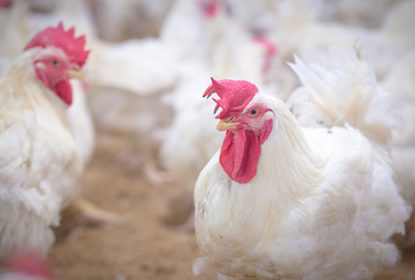
Flock welfare, Global TOP NEWS, Interviews, News, PHT GLOBAL, PHT US, Podcast, Research, TOP NEWS, Videos
... Environmental enrichments increased broiler activity in study
Nov 25, 2022Jennifer GrullonComments Off on Environmental enrichments increased broiler activity in study
Environmental enrichments in broiler houses may improve bird welfare by increasing natural behaviors, according to a University of Maryland study.... Study exposes Salmonella-contamination risks of integrated broiler production
Nov 22, 2022Jennifer GrullonComments Off on Study exposes Salmonella-contamination risks of integrated broiler production
Integrated broiler producers in Europe pose a risk of transmitting and maintaining clones of Salmonella throughout the production chain, according to researchers in Spain.... HPAI pushes holiday turkey prices to record highs
Nov 15, 2022Jennifer GrullonComments Off on HPAI pushes holiday turkey prices to record highs
The widespread outbreak of Highly Avian Pathogenic Avian Influenza (HPAI) across the US is expected to push up the cost of turkeys to record highs this holiday season. What does CoBank say about the...... Inclusion body hepatitis re-emergence prompts fresh look at control strategies
Nov 10, 2022Jennifer GrullonComments Off on Inclusion body hepatitis re-emergence prompts fresh look at control strategies
The US broiler industry is seeing a re-emergence of inclusion body hepatitis, a deadly disease that can strike with little warning. Take a look at our special report.... Long-term control for IBH includes vaccines, management protocols
Nov 03, 2022Jennifer GrullonComments Off on Long-term control for IBH includes vaccines, management protocols
Inclusion body hepatitis (IBH) remains a nagging issue for broiler flocks, and it isn’t going away anytime soon.... Five key points to consider when preparing to switch to in ovo vaccination
Nov 01, 2022Jennifer GrullonComments Off on Five key points to consider when preparing to switch to in ovo vaccination
A steady shift to in ovo vaccination in the Asia-Pacific region is encouraging many hatcheries there to improve practices and management in preparation for the switch.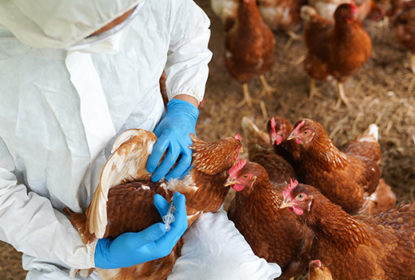
Diagnostics, Flock welfare, Global TOP NEWS, Infectious Diseases, News, PHT GLOBAL, PHT US, TOP NEWS
... Vaccines, biosecurity, management keys to keeping IBH in check
Oct 28, 2022Jennifer GrullonComments Off on Vaccines, biosecurity, management keys to keeping IBH in check
Inclusion body hepatitis can be a challenging disease, as the clinical signs are non-specific and there is no direct treatment. Consequently, producers rely on interventions such vaccinations.
Flock welfare, Global TOP NEWS, Hatchery, Interviews, News, PHT GLOBAL, PHT US, Podcast, Research, TOP NEWS, Videos
... Study: Day length during brooding did not impact broiler performance
Oct 20, 2022Jennifer GrullonComments Off on Study: Day length during brooding did not impact broiler performance
Extended day length during the brooding period is thought to benefit broilers’ long-term performance and well-being. However, a University of Georgia study has re-evaluated that idea.
Antibiotic-free, Flock welfare, Food Safety, Global TOP NEWS, Interviews, News, PHT GLOBAL, PHT US, Podcast, TOP NEWS, Videos
... Live-vaccine program a ‘must have’ to deal with cage-free E. coli challenge
Oct 10, 2022Jennifer GrullonComments Off on Live-vaccine program a ‘must have’ to deal with cage-free E. coli challenge
A higher risk of bacterial challenges in cage-free egg production means a live-vaccination program against Escherichia coli is a “must-have minimum” for flocks reared in alternative systems.
Biosecurity, Flock welfare, Global TOP NEWS, Infectious Diseases, News, PHT GLOBAL, PHT US, TOP NEWS
... HPAI prevention requires ‘buckle-up’ mentality to biosecurity
Oct 06, 2022Jennifer GrullonComments Off on HPAI prevention requires ‘buckle-up’ mentality to biosecurity
The only option for poultry farms to prevent an outbreak of highly pathogenic avian influenza (HPAI) is 100% adherence to biosecurity rules.... Anticoccidial sensitivity tests: Useful or not?
Oct 06, 2022Jennifer GrullonComments Off on Anticoccidial sensitivity tests: Useful or not?
By Philip A. Stayer, DVM, MS, ACPV, Corporate Veterinarian, Sanderson Farms, Inc.... No consensus on future success of Salmonella control for poultry industry
Oct 05, 2022Jennifer GrullonComments Off on No consensus on future success of Salmonella control for poultry industry
Opinions about the poultry industry’s future success in controlling Salmonella differ widely, judging by comments from panelists at a food-safety roundtable.... COVID pandemic had some positive effects on poultry health and welfare
Sep 29, 2022Jennifer GrullonComments Off on COVID pandemic had some positive effects on poultry health and welfare
Management techniques adopted to cope with COVID-19 production challenges led to improvements in bird health and welfare for many poultry producers.
Flock welfare, Food Safety, Global TOP NEWS, Interviews, News, PHT GLOBAL, PHT US, Podcast, Research, TOP NEWS, Videos
... Salmonella serotypes are changing — monitor which ones are in your flock
Sep 28, 2022Jennifer GrullonComments Off on Salmonella serotypes are changing — monitor which ones are in your flock
It’s imperative for poultry producers and companies to know what strains of Salmonella may be circulating in their flocks, said Chuck Hofacre, president of the Southern Poultry Research Group in...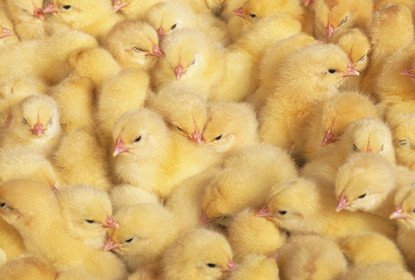
Flock welfare, Global TOP NEWS, Hatchery, Interviews, News, PHT GLOBAL, PHT US, Podcast, TOP NEWS, Videos
... Recombinant vaccines for poultry: How to maximize results
Sep 22, 2022Jennifer GrullonComments Off on Recombinant vaccines for poultry: How to maximize results
Proper vaccine handling, dosage and administration are key to ensuring thorough and effective coverage. That statement is particularly true when talking about recombinant-vector vaccines.... ILT vaccine choices: A closer look
Sep 20, 2022Jennifer GrullonComments Off on ILT vaccine choices: A closer look
With continued wild-type ILT challenges in the field, we are faced with a choice of two vaccine options with proven results — with different priorities affecting the final decision.... Avian flu likely to re-emerge and threaten US poultry flocks this fall
Sep 15, 2022Jennifer GrullonComments Off on Avian flu likely to re-emerge and threaten US poultry flocks this fall
US egg and turkey supplies took a hit from highly pathogenic avian influenza (HPAI) this spring as the wild-bird migration exposed domestic flocks to the virus.
Food Safety, Global TOP NEWS, Interviews, News, PHT GLOBAL, PHT US, Podcast, Research, TOP NEWS, Videos
... Study highlights risk of high Salmonella exposure, more persistent serotypes
Sep 10, 2022Jennifer GrullonComments Off on Study highlights risk of high Salmonella exposure, more persistent serotypes
Feed conversion takes a bigger hit in birds with higher Salmonella exposure, while Salmonella Reading outlasts other serotypes through the grow-out period, suggests new work from the University of...
Condemnations, Food Safety, Global TOP NEWS, Interviews, News, PHT GLOBAL, PHT US, Podcast, TOP NEWS, Videos
... USDA evaluating Salmonella-reduction steps along the poultry supply chain
Sep 08, 2022Jennifer GrullonComments Off on USDA evaluating Salmonella-reduction steps along the poultry supply chain
Almost 25% of US foodborne illnesses continue to be linked to poultry products. To get an accurate measure of product contamination, USDA is evaluating the poultry supply chain.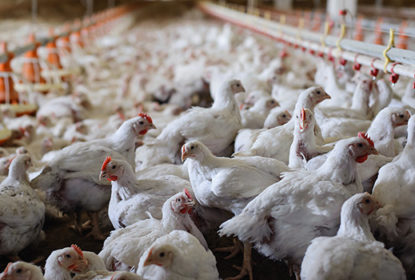
Diagnostics, Flock welfare, Global TOP NEWS, Infectious Diseases, News, PHT GLOBAL, PHT US, TOP NEWS
... IBH gaining more attention in broiler flocks as incidence, mortalities rise
Sep 01, 2022Jennifer GrullonComments Off on IBH gaining more attention in broiler flocks as incidence, mortalities rise
Inclusion body hepatitis (IBH) is not a new disease of poultry, but it’s quietly spreading to broiler flocks — initially with few clinical signs, followed by death in some flocks.... PHT Perspectives captures highlights of timely poultry health discussions
Aug 25, 2022Jennifer GrullonComments Off on PHT Perspectives captures highlights of timely poultry health discussions
Poultry Health Today has introduced a new editorial feature called PHT Perspectives, which provides quick-read highlights of recent webinars and roundtables organized by the editors.... Study shows modified-live vaccine can aid fight against Salmonella Infantis
Aug 24, 2022Jennifer GrullonComments Off on Study shows modified-live vaccine can aid fight against Salmonella Infantis
New research shows that using a modified-live Salmonella Typhimurium (ST) vaccine helps protect broilers against Salmonella Infantis, the most commonly-isolated serotype in chicken parts and...... Use ‘tools of discovery’ and all your senses to identify emerging poultry diseases
Aug 23, 2022Jennifer GrullonComments Off on Use ‘tools of discovery’ and all your senses to identify emerging poultry diseases
Emerging and re-emerging diseases can cause sudden, potentially catastrophic illness and death in commercial poultry flocks, said R.M. “Mick” Fulton, DVM, PhD, Michigan State University...... Cooling chickens with sprinklers has multiple benefits
Aug 18, 2022Jennifer GrullonComments Off on Cooling chickens with sprinklers has multiple benefits
By Tom Tabler, PhD, Extension Professor, Mississippi State University, Extension Service, Poultry Science Department, Mississippi State, Mississippi... New insights for managing coccidiosis in broilers
Aug 11, 2022Jennifer GrullonComments Off on New insights for managing coccidiosis in broilers
Despite industry advances, coccidiosis remains the leading intestinal health challenge in broilers. Poultry Health Today asked experts to share their latest insights and recommendations for managing...... Tuning up live-vaccine priming for infectious bursal disease and reovirus
Aug 11, 2022Jennifer GrullonComments Off on Tuning up live-vaccine priming for infectious bursal disease and reovirus
TOOLBOX, Issue 13: An interview with Kalen Cookson, DVM, MAM, Director of Clinical Research, Zoetis... Live vaccines are key to Salmonella-control programs — here’s why
Jul 19, 2022Jennifer GrullonComments Off on Live vaccines are key to Salmonella-control programs — here’s why
Immune responses to Salmonella infection are complex, but vaccination has become a key component of multi-step control programs. A new review of evidence to date suggests that live vaccines have...... Free booklet offers insights for addressing IBH in broilers
Jul 14, 2022Jennifer GrullonComments Off on Free booklet offers insights for addressing IBH in broilers
Poultry veterinarians throughout the US broiler industry are reporting a re-emergence of inclusion body hepatitis (IBH). The disease, caused by fowl adenovirus (FAdV), often strikes with little...... Limiting E. coli transmission from hen to offspring
Jun 04, 2022Jennifer GrullonComments Off on Limiting E. coli transmission from hen to offspring
TOOLBOX: An interview with Henrik Christensen, PhD, DVSc, University of Copenhagen, on the effect of Poulvac E. coli on bird health, laying performance and hatching results.
Flock welfare, Food Safety, Global TOP NEWS, Interviews, News, PHT GLOBAL, PHT US, Podcast, Research, TOP NEWS, Videos
... ‘Competitive exclusion’ is potential benefit of live Salmonella vaccines in young birds
Jun 02, 2022Jennifer GrullonComments Off on ‘Competitive exclusion’ is potential benefit of live Salmonella vaccines in young birds
Live vaccines for Salmonella have been found to start offering protection within a few days of administration, acting “almost as a [form of] competitive exclusion,” said Chuck Hofacre, president...... Avian flu strain behind recent outbreaks related but not identical to 2014-15 strain
Jun 02, 2022Jennifer GrullonComments Off on Avian flu strain behind recent outbreaks related but not identical to 2014-15 strain
The US poultry industry is on high alert following reports of highly pathogenic avian influenza (HPAI) in both wild birds and commercial flocks in poultry-dense regions of the US market.... Colibacillosis control in egg-laying chickens: A new tool in our toolbox
May 25, 2022Jennifer GrullonComments Off on Colibacillosis control in egg-laying chickens: A new tool in our toolbox
By Paul McMullin, MVB, MSc, DPMP, DiplECPVS, FRCVS, Consultant Veterinarian, Poultry Health International... Salmonella Enteritidis in feed can be a source for broiler flocks
May 11, 2022Jennifer GrullonComments Off on Salmonella Enteritidis in feed can be a source for broiler flocks
The Southern Poultry Research Group created a challenge model to show how S. Enteritidis, can spread among birds when feed is contaminated and to help evaluate products that can eliminate or reduce...... In ovo administration of recombinant HVT vector vaccines ‘perfect combination’ of microbiology and engineering
Apr 27, 2022Jennifer GrullonComments Off on In ovo administration of recombinant HVT vector vaccines ‘perfect combination’ of microbiology and engineering
TOOLBOX, Issue 30: An interview with Alberto Giner, DVM, poultry technical manager, Zoetis on in ovo administration of recombinant HVT vector vaccines.... With avian flu outbreaks, even the Easter bunny is hunting for eggs
Apr 07, 2022Jennifer GrullonComments Off on With avian flu outbreaks, even the Easter bunny is hunting for eggs
The US egg supply is under pressure, first from the impact of Covid-19 and now due to outbreaks of highly pathogenic avian influenza (HPAI).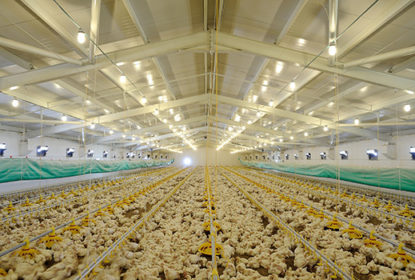
Biosecurity, Global TOP NEWS, Gut Health, Interviews, News, PHT GLOBAL, PHT US, Podcast, TOP NEWS, Videos
... Comparing necrotic enteritis litter models highlights performance impacts
Apr 06, 2022Jennifer GrullonComments Off on Comparing necrotic enteritis litter models highlights performance impacts
Reused litter from a previous NE challenge led to more severe subclinical performance impacts but fewer clinical signs of disease than in birds raised on fresh litter.... First seven days are crucial in ensuring layer chick quality
Mar 23, 2022Jennifer GrullonComments Off on First seven days are crucial in ensuring layer chick quality
Chick quality is crucial in the laying-hen business, and for Ian Rubinoff, DVM, director of global technical services for Hy-Line International, the first 7 days “have an outsized importance.”... Conventional, recombinant MD vaccination protocols compared in long-lived birds
Mar 08, 2022Jennifer GrullonComments Off on Conventional, recombinant MD vaccination protocols compared in long-lived birds
TOOLBOX, Issue 34: An interview with Eduardo Muniz, DVM, Zoetis on research comparing conventional vaccine programs versus new protocols with vectored vaccines.... E. coli vaccination reduces bacteria populations, increases antibiotic susceptibility
Mar 02, 2022Jennifer GrullonComments Off on E. coli vaccination reduces bacteria populations, increases antibiotic susceptibility
A modified-live E. coli vaccine helps reduce E. coli counts in broiler chickens and turkeys and can significantly increase susceptibility to commonly used antibiotics, according to new field...... What lessons can poultry producers learn from extreme weather events?
Feb 16, 2022Jennifer GrullonComments Off on What lessons can poultry producers learn from extreme weather events?
Extreme weather can pose a serious challenge for poultry producers — and with weather conditions proving ever-more volatile in some of the US’s key poultry production regions, improved planning...... Four-year study highlights value of vaccinating turkeys against E.coli
Feb 15, 2022Jennifer GrullonComments Off on Four-year study highlights value of vaccinating turkeys against E.coli
Vaccinating turkeys against colibacillosis with the modified-live E. coli vaccine has economic and animal welfare benefits, according to a retrospective, 4-year study conducted on 37 French turkey...... What does it take to be a successful poultry grower? Experts share their views
Jan 19, 2022Jennifer GrullonComments Off on What does it take to be a successful poultry grower? Experts share their views
Successful contract poultry farmers are hard workers, detail oriented and must literally serve as the gatekeepers of biosecurity, several experts and industry insiders say.... AL2 variants now account for more than half of IBDV field isolates in broilers
Dec 25, 2021Jennifer GrullonComments Off on AL2 variants now account for more than half of IBDV field isolates in broilers
DISCOVERIES, Issue 10: AL2 variants now account for more than half of the infectious bursal disease virus (IBDV) field isolates in broilers, according to the results of a 5-year survey.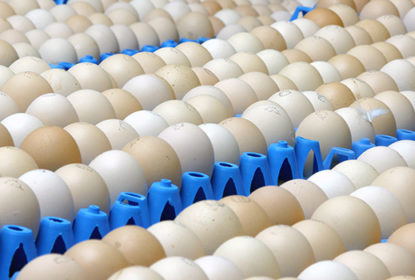
Diagnostics, Global TOP NEWS, Hatchery, Interviews, News, PHT GLOBAL, PHT US, Podcast, Respiratory, TOP NEWS, Videos
... Early infectious bronchitis virus infection causes more severe false layer syndrome
Dec 22, 2021Jennifer GrullonComments Off on Early infectious bronchitis virus infection causes more severe false layer syndrome
Exposure to IBV has been linked with cases of false-layer syndrome, where large cysts in the oviduct prevent birds from laying eggs.... Keeping up with coccidiosis remains challenging
Dec 21, 2021Jennifer GrullonComments Off on Keeping up with coccidiosis remains challenging
By Philip A. Stayer, DVM, ACPV, Corporate Veterinarian, Sanderson Farms, Inc.... Tackling a botulism outbreak in a breeder flock
Dec 16, 2021Jennifer GrullonComments Off on Tackling a botulism outbreak in a breeder flock
Botulism might not be a common occurrence in poultry production, but when it infects a flock, mortalities can be high. That was the situation Sara Throne, DVM, senior director of veterinary services...... Lowering Salmonella load at processing requires company-wide effort initiated from the top
Dec 08, 2021Jennifer GrullonComments Off on Lowering Salmonella load at processing requires company-wide effort initiated from the top
Lowering the load of Salmonella going into the processing plant requires a company-wide effort initiated from the top, panelists advised at a roundtable on food safety.
Global TOP NEWS, Hatchery, Interviews, News, PHT GLOBAL, PHT US, Podcast, Respiratory, TOP NEWS, Videos
... Essential adjustments that improve IB vaccine efficacy in broilers
Dec 05, 2021Jennifer GrullonComments Off on Essential adjustments that improve IB vaccine efficacy in broilers
A few essential adjustments in the way infectious bronchitis vaccines are handled and administered at the hatchery can improve vaccine efficacy.... Measuring temperature of birds’ faces could help identify heat stress in flocks
Nov 08, 2021Jennifer GrullonComments Off on Measuring temperature of birds’ faces could help identify heat stress in flocks
Use of thermal imaging cameras to measure facial temperatures may offer a non-invasive option for assessing heat stress in commercial broilers, according to research from the University of Arkansas.... Targeted adjuvants may improve recombinant ILT vaccination immune response
Nov 02, 2021Jennifer GrullonComments Off on Targeted adjuvants may improve recombinant ILT vaccination immune response
Vaccination might be effective in controlling ILT in broilers, but recombinant vaccines might not always provide an adequate immune response, according to scientists at North Caroline State...
Biosecurity, Global TOP NEWS, Infectious Diseases, Interviews, News, PHT US, Podcast, TOP NEWS, Videos, Zoetis News Center
... Details matter when it comes to ILT vaccination success
Oct 06, 2021Jennifer GrullonComments Off on Details matter when it comes to ILT vaccination success
Attention to detail is key to successfully vaccinating broiler flocks against infectious laryngotracheitis (ILT), according to a poultry health expert.... Direct-fed microbials can impact Salmonella vaccine efficacy
Sep 22, 2021Jennifer GrullonComments Off on Direct-fed microbials can impact Salmonella vaccine efficacy
Some direct-fed microbial additives with live cultures have been found to impact the efficacy of modified-live vaccines.... Pullet vaccination: There’s always room for improvement
Sep 20, 2021Jennifer GrullonComments Off on Pullet vaccination: There’s always room for improvement
TOOLBOX, Issue 17: An interview with Tim Cummings, DVM, Senior Technical Services Veterinarian, Zoetis... IBD control in egg layers has unique challenges
Sep 20, 2021Jennifer GrullonComments Off on IBD control in egg layers has unique challenges
By Daral J. Jackwood, PhD, Professor, The Ohio State University... Feed additive appears to benefit gut integrity in broilers with coccidiosis
Sep 16, 2021Jennifer GrullonComments Off on Feed additive appears to benefit gut integrity in broilers with coccidiosis
The feed additive sodium bisulfate administered to broilers during a coccidial challenge appeared to benefit gut integrity.
Diagnostics, Global TOP NEWS, Interviews, News, PHT GLOBAL, PHT US, Podcast, Respiratory, TOP NEWS, Videos, Zoetis News Center
... Periodic IBV PCR testing is key to ensuring vaccination efficacy
Sep 09, 2021Jennifer GrullonComments Off on Periodic IBV PCR testing is key to ensuring vaccination efficacy
Complexes should regularly evaluate the infectious bronchitis viruses (IBV) prevalent on their farms to help determine which vaccines can provide the best protection possible.... Free food safety booklet showcases poultry industry ideas for tackling Salmonella
Sep 09, 2021Jennifer GrullonComments Off on Free food safety booklet showcases poultry industry ideas for tackling Salmonella
Reducing the prevalence of foodborne Salmonella is essential if poultry companies are to improve food safety and pass muster with USDA’s Food Safety and Inspection Service performance standards.... Five critical factors for in ovo vaccination success
Sep 03, 2021Jennifer GrullonComments Off on Five critical factors for in ovo vaccination success
In ovo vaccination has proven popular in commercial hatcheries as it can offer early immunity against prevalent pathogens, consistent vaccine delivery and a less labor-intensive process involving...
Diagnostics, Global TOP NEWS, Infectious Diseases, Interviews, News, PHT GLOBAL, PHT US, Podcast, TOP NEWS, Videos
... Molecular test helps identify pathogenicity in new strains of infectious bursal disease virus
Sep 03, 2021Jennifer GrullonComments Off on Molecular test helps identify pathogenicity in new strains of infectious bursal disease virus
A genetic technique which could help improve predictions about the virulence of infectious bursal disease (IBDV) has identified pathogenicity in seven new strains of the virus which causes an...... Reaction of poultry company customers to FSIS performance standards varied
Aug 26, 2021Jennifer GrullonComments Off on Reaction of poultry company customers to FSIS performance standards varied
Publication of USDA performance standards prompted some poultry company customers to refuse product from processing plants in Category 3, according to participants at a food safety roundtable.... False layer syndrome in Canada due to DMV/1639
Aug 15, 2021Jennifer GrullonComments Off on False layer syndrome in Canada due to DMV/1639
False layer syndrome due to the Delmarva 1639 (DMV/1639) variant of the infectious bronchitis virus (IBV) is leading to huge economic losses in the Canadian egg industry.... Salmonella control in hatchery, second processing require special attention
Aug 09, 2021Jennifer GrullonComments Off on Salmonella control in hatchery, second processing require special attention
Interventions for Salmonella control throughout the production process are essential, but special attention at the hatchery and during second processing at the plant are critical to success,...
Global TOP NEWS, Infectious Diseases, Interviews, News, PHT GLOBAL, PHT US, Respiratory, TOP NEWS, Videos
... Three keys to successful IBV control
Aug 09, 2021Jennifer GrullonComments Off on Three keys to successful IBV control
Highly contagious and constantly evolving, infectious bronchitis virus (IBV) is notoriously difficult to control.... Hatcheries in NAE production systems can’t cut corners on cleaning, husbandry
Aug 04, 2021Jennifer GrullonComments Off on Hatcheries in NAE production systems can’t cut corners on cleaning, husbandry
Hatcheries providing chicks for no antibiotics ever (NAE) production need to be meticulous with cleanliness and good husbandry practices in order for the program to succeed.
Global TOP NEWS, Infectious Diseases, Interviews, News, PHT GLOBAL, PHT US, Podcast, Respiratory, TOP NEWS, Videos
... Two years of IBV sampling underlines importance of surveillance work
Aug 03, 2021Jennifer GrullonComments Off on Two years of IBV sampling underlines importance of surveillance work
Large-scale collection of samples from producers across the southern US is helping shed new light on infectious bronchitis virus (IBV) in chicken flocks — including uncovering a new serotype of the...... Special Report: Reducing Salmonella, ensuring food safety in poultry production
Jul 06, 2021Jennifer GrullonComments Off on Special Report: Reducing Salmonella, ensuring food safety in poultry production
In a new Special Report, Poultry Health Today taps the industry pulse on the latest efforts to minimize risks in live production and processing, with expert insight on the present and future of...
Antibiotic-free, Biosecurity, Food Safety, Global TOP NEWS, Interviews, News, PHT GLOBAL, PHT US, Podcast, Research, TOP NEWS, Videos
... Better management, biosecurity could mean lower Salmonella levels in NAE farms
Jul 03, 2021Jennifer GrullonComments Off on Better management, biosecurity could mean lower Salmonella levels in NAE farms
New research has suggested that Salmonella levels in no-antibiotics-ever (NAE) poultry systems could be lower than those on conventional broiler farms.... Litter problems persist
Jul 01, 2021Jennifer GrullonComments Off on Litter problems persist
By Tom Tabler, PhD, Extension Professor, Mississippi State University Extension Service, Poultry Science Department, Mississippi State, MS
Biosecurity, Food Safety, Global TOP NEWS, Interviews, News, PHT GLOBAL, PHT US, Podcast, TOP NEWS, Videos
... Litter management can help control Salmonella Heidelberg
Jun 28, 2021Jennifer GrullonComments Off on Litter management can help control Salmonella Heidelberg
Ongoing studies to find ways of managing Salmonella Heidelberg loads in poultry litter have suggested that downtime is key to reducing the pathogen’s rates.
Food Safety, Global TOP NEWS, Gut Health, Interviews, News, PHT GLOBAL, PHT US, Podcast, Sustainability, TOP NEWS, Videos
... Right skills critical to managing increases in Salmonella, coccidiosis associated with cage-free egg production
Jun 23, 2021Jennifer GrullonComments Off on Right skills critical to managing increases in Salmonella, coccidiosis associated with cage-free egg production
Producers making the switch to cage-free egg production need to ensure they are properly prepared for managing potential increases in Salmonella and other health challenges.
Diagnostics, Global TOP NEWS, Infectious Diseases, Interviews, News, PHT GLOBAL, PHT US, TOP NEWS, Videos
... Diagnostics key to effective mycoplasma control
Jun 20, 2021Jennifer GrullonComments Off on Diagnostics key to effective mycoplasma control
Avian mycoplasmosis is a problem for poultry producers worldwide, but according to an expert, there’s no “one-size-fits-all” approach to managing it.... Temperature and air flow critical to broiler performance year-round
Jun 07, 2021Jennifer GrullonComments Off on Temperature and air flow critical to broiler performance year-round
By Michael Czarick, Engineering Specialist, University of Georgia Department of Poultry Science... Control key to protecting flocks from more virulent, resistant E. coli
Jun 03, 2021Jennifer GrullonComments Off on Control key to protecting flocks from more virulent, resistant E. coli
Research shows many strains of E. coli are capable of causing disease directly. And with antibiotic resistance on the rise, control and prevention are essential.... Management of birds and environment reduce industry’s carbon footprint
Jun 02, 2021Jennifer GrullonComments Off on Management of birds and environment reduce industry’s carbon footprint
Pressure to reduce poultry production’s carbon footprint presents multiple hurdles, but the industry is up to the challenge, said Joseph Giambrone, PhD, professor, Auburn University.... Tackling stress key to protecting birds from coryza resurgence, says expert
Jun 02, 2021Jennifer GrullonComments Off on Tackling stress key to protecting birds from coryza resurgence, says expert
Limiting stress in broiler flocks is key to preventing birds from succumbing to an infectious respiratory disease which is showing a resurgence in some areas of the US, according to a poultry expert.... Infectious bronchitis DMV 1639: More questions than answers
Jun 01, 2021Jennifer GrullonComments Off on Infectious bronchitis DMV 1639: More questions than answers
By Philip A. Stayer, DVM, MS, ACPV, Corporate Veterinarian, Sanderson Farms, Inc.
Biosecurity, Diagnostics, Food Safety, Global TOP NEWS, Interviews, News, PHT GLOBAL, PHT US, Podcast, TOP NEWS, Videos
... Utilizing on-farm testing key to helping processors understand S. Infantis loads
May 25, 2021Jennifer GrullonComments Off on Utilizing on-farm testing key to helping processors understand S. Infantis loads
Using a range of testing methods for Salmonella Infantis can help broiler companies build a better picture of how effective interventions against the pathogen are performing.... E. coli vaccination in broilers: Is it worth the cost?
May 15, 2021Jennifer GrullonComments Off on E. coli vaccination in broilers: Is it worth the cost?
According to recent studies, E. coli vaccination may actually help broiler producers boost their bottom lines.... Calcium toxicity cases underscore value of networking for knowledge
May 15, 2021Jennifer GrullonComments Off on Calcium toxicity cases underscore value of networking for knowledge
By Philip A. Stayer, DVM, MS, ACPV, Corporate Veterinarian, Sanderson Farms, Inc.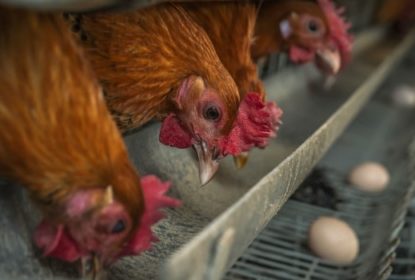
Global TOP NEWS, Infectious Diseases, Interviews, News, PHT GLOBAL, PHT US, Podcast, Research, TOP NEWS, Videos
... False layer syndrome linked to early infectious bronchitis exposure
May 14, 2021Jennifer GrullonComments Off on False layer syndrome linked to early infectious bronchitis exposure
Research is increasingly linking false layer syndrome to early exposure to infectious bronchitis virus. The condition prevents laying hens from producing eggs, but birds display few outward signs of...... Hatchery details key to maximizing chick performance, expert says
Apr 01, 2021Jennifer GrullonComments Off on Hatchery details key to maximizing chick performance, expert says
A back-to-basics approach toward managing, handling and storing eggs can help maximize the quality and hatchability of chicks being produced for broiler flocks, according to an industry expert.... Incubation key to preventing leg problems in turkey poults
Mar 31, 2021Jennifer GrullonComments Off on Incubation key to preventing leg problems in turkey poults
Managing heat and humidity in hatcheries is key to reducing costly leg problems in turkey poults.... New vaccine simplifies IBDV vaccination; provides effective early pullet protection
Mar 18, 2021Jennifer GrullonComments Off on New vaccine simplifies IBDV vaccination; provides effective early pullet protection
TOOLBOX, Issue 25: An interview with John Brown, DVM, senior technical services veterinarian and layer specialist, Zoetis on early pullet protection from IBDV.... SPECIAL REPORT: Don’t let immunosuppressive diseases compromise broiler performance
Feb 02, 2021Jennifer GrullonComments Off on SPECIAL REPORT: Don’t let immunosuppressive diseases compromise broiler performance
Immunosuppressive diseases such as IBDV, Marek's and reovirus can compromise a bird's ability to fight off secondary infections. Keeping them in check becomes even more critical as poultry companies...... Good gut health can help minimize Salmonella in broilers
Dec 17, 2020Jennifer GrullonComments Off on Good gut health can help minimize Salmonella in broilers
TOOLBOX, Issue 14: An interview with Manuel Da Costa, DVM, PhD, Associate Director, Outcomes Research, Zoetis... Now more than ever, vaccination is critical for managing Salmonella in layer flocks
Nov 28, 2020Jennifer GrullonComments Off on Now more than ever, vaccination is critical for managing Salmonella in layer flocks
TOOLBOX, Issue 22: An interview with Kalen Cookson, DVM, MAM, Director of Clinical Research, Zoetis... S. Heidelberg load reduced in chicks treated with acidified water the first 2 weeks of life
Nov 19, 2020Jennifer GrullonComments Off on S. Heidelberg load reduced in chicks treated with acidified water the first 2 weeks of life
DISCOVERIES, Issue 9: Chicks that received acidified water for the first 2 weeks of life had a significantly reduced load of Salmonella Heidelberg, a challenge study demonstrates.
Flock welfare, Global TOP NEWS, Infectious Diseases, Interviews, News, PHT GLOBAL, PHT US, Podcast, Research, TOP NEWS, Videos
... Consider predominance of AL-2 variants when planning IBDV vaccination program
Nov 09, 2020Jennifer GrullonComments Off on Consider predominance of AL-2 variants when planning IBDV vaccination program
The AL-2 family of variants is the predominant strain of infectious bursal disease virus (IBDV) circulating among US broiler flocks, according to a recent survey.
Antibiotic-free, Global TOP NEWS, Gut Health, Interviews, News, PHT GLOBAL, PHT US, Podcast, Research, TOP NEWS, Videos
... Glutamine supplement shows promise in reducing necrotic enteritis
Oct 26, 2020Jennifer GrullonComments Off on Glutamine supplement shows promise in reducing necrotic enteritis
Supplementing poultry diets with glutamine could help reduce the severity of necrotic enteritis (NE), according to researchers.... Studies in 32 million birds show returns on vaccinating broilers for E. coli
Oct 22, 2020Jennifer GrullonComments Off on Studies in 32 million birds show returns on vaccinating broilers for E. coli
DISCOVERIES, Issue 8: In studies conducted in more than 32 million broiler chickens in Italy and the US, vaccination with Poulvac® E. coli yielded a positive return on investment.... Training and management critical for cage-free egg production
Aug 27, 2020Jennifer GrullonComments Off on Training and management critical for cage-free egg production
Training chicks and pullets so they are prepared for life in cage-free egg systems is critical to ensuring they meet their full productive potential.
Antibiotic-free, Global TOP NEWS, Hatchery, Interviews, News, PHT GLOBAL, PHT US, Podcast, TOP NEWS, Videos
... Chick quality vital to no-antibiotics-ever success, consultant says
Aug 20, 2020Jennifer GrullonComments Off on Chick quality vital to no-antibiotics-ever success, consultant says
Focusing on chick quality from the moment eggs enter the incubator is critical to ensuring birds have the best chance of being healthy and productive in no-antibiotics-ever (NAE) systems.... New Poulvac Maternavac® 4 vaccine formulated to address contemporary field challenge
Jul 23, 2020Jennifer GrullonComments Off on New Poulvac Maternavac® 4 vaccine formulated to address contemporary field challenge
DISCOVERIES, Issue 6: The rapid growth in reduced and “no antibiotics ever” production was the driving force behind development of a new vaccine to protect chickens against four costly diseases.... Vaccination with Poulvac® E. coli yields economic benefits in broilers
Jul 07, 2020Jennifer GrullonComments Off on Vaccination with Poulvac® E. coli yields economic benefits in broilers
DISCOVERIES, Issue 7: Vaccinating broilers against Escherichia coli yielded a favorable return on investment in a recent trial... USDA urged to give producers time to trial Campylobacter and Salmonella interventions
Jun 28, 2020Jennifer GrullonComments Off on USDA urged to give producers time to trial Campylobacter and Salmonella interventions
Greater flexibility is needed in official Salmonella and Campylobacter testing regimes in order to support poultry producers and processors who are trialing new interventions to tackle both... Study: Live S. Typhimurium vaccine reduces S. Infantis colonization
Jun 10, 2020Jennifer GrullonComments Off on Study: Live S. Typhimurium vaccine reduces S. Infantis colonization
Investing in vaccination programs to develop cross-protection against some of the most common strains of Salmonella could help limit the number of foodborne outbreaks of the pathogen.... Mountaire Farms is first company to carry the One Health Certified label
Jun 04, 2020Jennifer GrullonComments Off on Mountaire Farms is first company to carry the One Health Certified label
Mountaire Farms is the first animal protein company to carry the One Health Certified label, demonstrating its commitment to animal production standards established by the program.... Controlling infectious bronchitis in broilers starts with breeder vaccination
Apr 03, 2020Jennifer GrullonComments Off on Controlling infectious bronchitis in broilers starts with breeder vaccination
Protocols vary widely, but vaccinating broiler breeders against infectious bronchitis virus remains an important strategy for protecting broiler progeny against the virus.... Decisions, decisions: Which gut health strategies should be used when?
Feb 17, 2020Jennifer GrullonComments Off on Decisions, decisions: Which gut health strategies should be used when?
As the poultry industry moves to limit antibiotic use, alternative measures to support gut health are now common practice, but more guidance is needed with respect to which strategies to use under...... JAVMA report: Newcastle reemerges, spreads in California
Jan 30, 2020Jennifer GrullonComments Off on JAVMA report: Newcastle reemerges, spreads in California
Virulent Newcastle disease resurged in Southern California as people broke quarantines by moving birds and farming equipment, according to a report by JAVMA.... Managing anticoccidials: ‘It’s how you use them that’s important’
Dec 23, 2019Jennifer GrullonComments Off on Managing anticoccidials: ‘It’s how you use them that’s important’
Coccidiosis takes a toll of around $3 billion on global poultry production each year, making it one of the industry’s most economically significant diseases worldwide.... E. coli vaccination yields bottom-line benefits on South African broiler farms
Dec 10, 2019Jennifer GrullonComments Off on E. coli vaccination yields bottom-line benefits on South African broiler farms
New research from South Africa shows that vaccinating broilers against Escherichia coli is good not just for birds, but also for bottom lines.
Global TOP NEWS, Infectious Diseases, Interviews, News, PHT GLOBAL, PHT US, Podcast, TOP NEWS, Videos
... Unusual presentation of bacterial septicemia in broilers tied to breeders
Oct 29, 2019Jennifer GrullonComments Off on Unusual presentation of bacterial septicemia in broilers tied to breeders
An unusual presentation of bacterial septicemia in broilers underscores the importance of obtaining a good history and input from bird caretakers, according to David French, DVM, a staff veterinarian...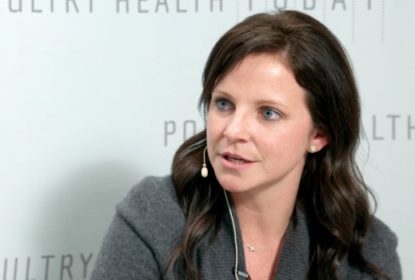
Diagnostics, Flock welfare, Global TOP NEWS, Infectious Diseases, Interviews, News, PHT GLOBAL, PHT US, Podcast, Respiratory, TOP NEWS, Videos
... Sentinel broilers, PCR testing help isolate, identify evolving IBV populations in Arkansas
Oct 07, 2019Jennifer GrullonComments Off on Sentinel broilers, PCR testing help isolate, identify evolving IBV populations in Arkansas
How do you look for new serotypes of a virus that might be circulating in an area? Sentinel birds are a good place to start, according to Abigail Reith, DVM, a technical services veterinarian for...... Reductions in medically important antimicrobials reflect industry stewardship
Oct 02, 2019Jennifer GrullonComments Off on Reductions in medically important antimicrobials reflect industry stewardship
Reductions in the use of medically important antimicrobials demonstrate the poultry industry’s commitment to stewardship of these valuable medications, Randall Singer, DVM, MPVM, PhD, told Poultry...... US poultry industry shifting focus to Campylobacter, Salmonella Infantis
Sep 19, 2019Jennifer GrullonComments Off on US poultry industry shifting focus to Campylobacter, Salmonella Infantis
The US poultry industry needs to revisit Campylobacter-control strategies in preparation for new performance standards coming from USDA’s Food Safety and Inspection Service, Ashley Peterson,...... Vaccinated birds shown to have lower incidence of Salmonella at processing
Sep 04, 2019Jennifer GrullonComments Off on Vaccinated birds shown to have lower incidence of Salmonella at processing
Broilers vaccinated against Salmonella showed reduced levels of the pathogen at processing in a recent study, according to Charles Hofacre, PhD, president, Southern Poultry Research Group. Inc.... Coccidiosis vaccination impedes nutrient digestibility
Aug 30, 2019Jennifer GrullonComments Off on Coccidiosis vaccination impedes nutrient digestibility
Poultry veterinarians and production managers are all too familiar with coccidiosis and its impact on gut health, nutrient absorption, feed conversion and growth rate.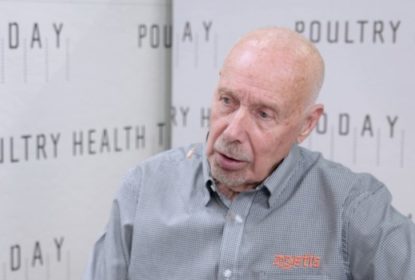
Antibiotic-free, Global TOP NEWS, Hatchery, Interviews, News, PHT GLOBAL, PHT US, Podcast, TOP NEWS, Videos
... Ensuring chick quality in NAE production
Jul 30, 2019Jennifer GrullonComments Off on Ensuring chick quality in NAE production
The increase in 7-day chick mortality that has come along with the elimination of antibiotics requires a focus on containing bacteria that start in the layer house.... Trial shows glutamine aids gut health in broilers raised without antibiotics
Jul 05, 2019Jennifer GrullonComments Off on Trial shows glutamine aids gut health in broilers raised without antibiotics
With the increase in no-antibiotic-ever production, glutamine may serve as a helpful nutrient asset, particularly when birds are under stress.... On the road again? Don’t forget Poultry Health Today podcasts
Jun 14, 2019Jennifer GrullonComments Off on On the road again? Don’t forget Poultry Health Today podcasts
Most of Poultry Health Today’s video interviews with leading health experts and other opinion leaders can be downloaded as podcasts and listened to on mobile devices or through audio systems of...... Pilgrim’s veterinarian shares experiences with NAE production
Jun 07, 2019Jennifer GrullonComments Off on Pilgrim’s veterinarian shares experiences with NAE production
Preparation, meticulous attention to sanitation and improved communication with hatchery staff and growers are critical for NAE production.... Four areas of hatchery management to help achieve better biosecurity
May 23, 2019Jennifer GrullonComments Off on Four areas of hatchery management to help achieve better biosecurity
Diligent attention to four areas of hatchery management — egg-pack quality, incubation, sanitation and in ovo vaccination — can go a long way.... Moving up: Vaccinating broilers may help poultry companies improve Salmonella ratings
May 13, 2019Jennifer GrullonComments Off on Moving up: Vaccinating broilers may help poultry companies improve Salmonella ratings
Vaccinating broilers against Salmonella could be an effective live-side intervention for obtaining higher ratings in the Salmonella categorizations established by the USDA’s FSIS
Biosecurity, Global TOP NEWS, Infectious Diseases, Interviews, News, PHT GLOBAL, PHT US, Podcast, Respiratory, TOP NEWS, Videos
... Virulent ND in California sending wake-up call to US poultry industry
May 08, 2019Jennifer GrullonComments Off on Virulent ND in California sending wake-up call to US poultry industry
Outbreaks of virulent Newcastle disease (vND) that have spread from backyard to commercial flocks in California are providing a wake-up call to the entire US poultry industry.... Bioshuttle program helps control E. tenella outbreaks in pullets
May 02, 2019Jennifer GrullonComments Off on Bioshuttle program helps control E. tenella outbreaks in pullets
Administration of an in-feed anticoccidial after coccidiosis vaccination has helped alleviate outbreaks of Eimeria tenella in broiler breeder replacement stock.... Aggressive vaccination of broiler breeders needed to keep reovirus in check
Apr 18, 2019Jennifer GrullonComments Off on Aggressive vaccination of broiler breeders needed to keep reovirus in check
Aggressive vaccination of broiler breeders for reovirus using live and inactivated vaccines has been one of the most important steps the US poultry industry has taken to maintain good protection...... Sanderson vet shares thoughts on managing elusive reovirus, other gut diseases
Mar 11, 2019Jennifer GrullonComments Off on Sanderson vet shares thoughts on managing elusive reovirus, other gut diseases
Autogenous vaccines used in a reovirus vaccination program need to be updated relatively often to keep up with changes in the pathogen... Poultry experts identify weak links in live production that can compromise Salmonella control
Mar 05, 2019Jennifer GrullonComments Off on Poultry experts identify weak links in live production that can compromise Salmonella control
Improved Salmonella control requires fixing weak links in live production that allow the pathogen to get into a flock, poultry experts advised during an industry roundtable.... Early exposure to Clostridium protects birds from necrotic enteritis
Feb 21, 2019Jennifer GrullonComments Off on Early exposure to Clostridium protects birds from necrotic enteritis
Early exposure to Clostridium perfringens in used litter may be a way to minimize the impact of necrotic enteritis (NE) in broilers, Steve Davis, DVM, told Poultry Health Today.... Necrotic enteritis control helps reduce Salmonella colonization
Feb 07, 2019Jennifer GrullonComments Off on Necrotic enteritis control helps reduce Salmonella colonization
Maintaining good intestinal health in broilers is essential for minimizing the presence of Salmonella in birds sent for processing, Manuel Da Costa, DVM, PhD, associate director for Outcomes Research...... Infectious bronchitis control: Understanding why it’s so difficult
Feb 05, 2019Jennifer GrullonComments Off on Infectious bronchitis control: Understanding why it’s so difficult
By Mark W. Jackwood, PhD, Department Head, JR Glisson Professor of Avian Medicine, University of Georgia... Refined carbs show promise as ‘sentinel’ for Salmonella control
Jan 23, 2019Jennifer GrullonComments Off on Refined carbs show promise as ‘sentinel’ for Salmonella control
Higher government standards for Salmonella control have put more pressure on poultry companies to reduce incidence on broiler farms and lower the pathogen load going into processing.... E. coli vaccination helps contain losses in broilers with IB infection
Jan 16, 2019Jennifer GrullonComments Off on E. coli vaccination helps contain losses in broilers with IB infection
Field experience with infectious bronchitis in broilers during a harsh winter demonstrated that vaccination for secondary Escherichia coli infection helped stem losses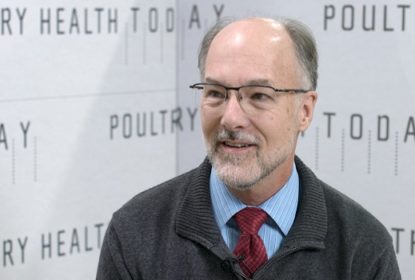
Antibiotic-free, Global TOP NEWS, Gut Health, Interviews, News, PHT GLOBAL, PHT US, Podcast, TOP NEWS, Videos
... Coccidiosis control, litter management key to NE prevention in broilers raised without antibiotics
Jan 10, 2019Jennifer GrullonComments Off on Coccidiosis control, litter management key to NE prevention in broilers raised without antibiotics
Good coccidiosis control and litter management are the two most important steps producers can take to prevent necrotic enteritis (NE) in flocks raised without antibiotics.... Chicks may hold clues to lameness in older birds
Jan 07, 2019Jennifer GrullonComments Off on Chicks may hold clues to lameness in older birds
Lameness in some poultry flocks has researchers searching for the cause, Suzanne Dougherty, DVM, a consulting poultry veterinarian based in Alabama, told Poultry Health Today.... It takes two: Coccidiosis vaccines effective against E. tenella after adequate cycling
Dec 26, 2018Jennifer GrullonComments Off on It takes two: Coccidiosis vaccines effective against E. tenella after adequate cycling
Coccidiosis vaccination was effective in broilers challenged with Eimeria tenella but only after vaccinal oocysts cycled twice, Laura Tensa, DVM, told Poultry Health Today.... IBV vaccination protects broilers despite ammonia exposure
Nov 19, 2018Jennifer GrullonComments Off on IBV vaccination protects broilers despite ammonia exposure
A recent study corroborates previous findings that broilers properly vaccinated for infectious bronchitis virus (IBV) are protected from IBV challenge despite exposure to moderate levels of ammonia.
Biosecurity, Global TOP NEWS, Infectious Diseases, Interviews, News, PHT GLOBAL, PHT US, Podcast, Respiratory, TOP NEWS, Videos
... Biosecurity, disinfection, downtime keys to better ILT control
Nov 01, 2018Jennifer GrullonComments Off on Biosecurity, disinfection, downtime keys to better ILT control
Strict biosecurity is the best defense against infectious laryngotracheitis (ILT) in broiler flocks, advises Maricarmen García, PhD, a professor at the University of Georgia.... Salmonella Infantis can complicate respiratory problems in broilers
Oct 26, 2018Jennifer GrullonComments Off on Salmonella Infantis can complicate respiratory problems in broilers
Salmonella Infantis can become a persistent problem in broilers and exacerbate mortality when combined with infectious bronchitis, experience indicates at an integrated South American poultry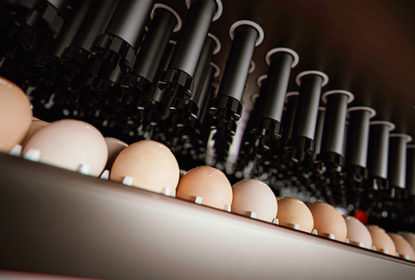
Global TOP NEWS, Hatchery, Infectious Diseases, Interviews, News, PHT GLOBAL, PHT US, Podcast, TOP NEWS, Videos
... Halting in ovo vaccination not a good option for managing hatchery bacteria
Oct 22, 2018Jennifer GrullonComments Off on Halting in ovo vaccination not a good option for managing hatchery bacteria
Higher 7-day mortality from bacterial infections in the hatchery is no reason to stop in ovo vaccination for Marek’s and other diseases, according to a consulting poultry veterinarian.... Uncertain supplies present challenges for rotation-minded producers
Oct 11, 2018Jennifer GrullonComments Off on Uncertain supplies present challenges for rotation-minded producers
Poultry producers know the importance of developing a long-term strategy for maintaining the efficacy of anticoccidials, but sometimes unexpected backorders of feed medications in high demand force...... Special report: Poultry veterinarians teaming up to reduce condemnations, optimize food safety
Sep 18, 2018Jennifer GrullonComments Off on Special report: Poultry veterinarians teaming up to reduce condemnations, optimize food safety
Minimizing carcass condemnations and reducing the load of foodborne pathogens moving from broiler farms into processing might seem like separate production objectives — and they are.... Trace minerals, used litter, coccidiosis control key to managing enteritis in NAE flocks
Sep 06, 2018Jennifer GrullonComments Off on Trace minerals, used litter, coccidiosis control key to managing enteritis in NAE flocks
Starting broiler flocks on used litter, coupled with effective coccidiosis control and the use of trace minerals, can help minimize necrotic enteritis (NE) in broiler flocks raised without...... E. coli becoming more common with rise in ‘no antibiotics ever’ programs
Aug 31, 2018Jennifer GrullonComments Off on E. coli becoming more common with rise in ‘no antibiotics ever’ programs
With the removal of antibiotics in the hatchery in “no antibiotics ever” (NAE) programs, the bacterium Escherichia coli is becoming more of a problem at many broiler complexes.... Marek’s and Salmonella: John Smith, DVM, offers insights on two new broiler-vaccination trends
Aug 23, 2018Jennifer GrullonComments Off on Marek’s and Salmonella: John Smith, DVM, offers insights on two new broiler-vaccination trends
John Smith, DVM, poultry veterinarian for Alectryon in Baldwin, Georgia, shared ideas with Poultry Health Today on two changes in broiler-vaccination strategies in the US poultry industry.... Coccidiosis control: New strategies for a new era
Aug 17, 2018Jennifer GrullonComments Off on Coccidiosis control: New strategies for a new era
Coccidiosis can be controlled in broilers without antibiotics as long as producers pay closer attention to hatchery coccidiosis vaccination procedures, brooding and stocking rates, Greg Mathis, PhD,...... Early identification needed to protect broilers from reovirus
Aug 16, 2018Jennifer GrullonComments Off on Early identification needed to protect broilers from reovirus
Reovirus is mutating every 2 to 3 years, which is making it difficult to protect broilers from the effects of the virus, Don Waldrip, DVM, technical service veterinarian for Zoetis, told Poultry...... Blackhead disease causes reduced egg production in layer hens
Aug 03, 2018Jennifer GrullonComments Off on Blackhead disease causes reduced egg production in layer hens
Blackhead disease can cause an important drop in egg production among commercial layer hens, Christina Sigmon of North Carolina State University, said during the 2018 International Poultry Scientific...... Research focusing on new controls for coccidiosis, relationship with Salmonella
Aug 02, 2018Jennifer GrullonComments Off on Research focusing on new controls for coccidiosis, relationship with Salmonella
Alternative products for coccidiosis control remain the focus of research, but so far, the results are inconsistent, Sam Hendrix, DVM, veterinarian and researcher at Colorado Quality Research, told...... Special Report: Nixing necrotic enteritis in broilers
Jul 09, 2018Jennifer GrullonComments Off on Special Report: Nixing necrotic enteritis in broilers
This week poultry specialists will gather in Denver, Colorado, for the second International Conference on Necrotic Enteritis. In this special report, Poultry Health Today looks at the impact of this...... Vaccination followed with feed medication gives pullets added protection against coccidiosis
Jul 02, 2018Jennifer GrullonComments Off on Vaccination followed with feed medication gives pullets added protection against coccidiosis
Inadequate coccidiosis protection in pullets can lead to health issues ranging from uneven weight gain to mortality.... Special Report: What’s the future of ionophores in poultry?
Jun 29, 2018Jennifer GrullonComments Off on Special Report: What’s the future of ionophores in poultry?
In this special report, Poultry Health Today looks at the role of ionophores in managing a ubiquitous disease that costs the world's poultry industry more than $2.4 billion a year.... The link between Salmonella and intestinal health
Jun 26, 2018Jennifer GrullonComments Off on The link between Salmonella and intestinal health
By Charles L. Hofacre, DVM, MAM, PhD President, Southern Poultry Research Group, Inc. Professor Emeritus, University of Georgia
Global TOP NEWS, Infectious Diseases, Interviews, PHT GLOBAL, PHT US, Podcast, Respiratory, TOP NEWS, Videos
... Is MS the next ‘big, bad Mycoplasma’ for US poultry?
Jun 20, 2018Jennifer GrullonComments Off on Is MS the next ‘big, bad Mycoplasma’ for US poultry?
The US poultry industry is reporting more problems with virulent Mycoplasma synoviae according to Naola Ferguson, DVM... Team effort by human, animal sectors needed to ensure responsible antibiotic use worldwide
Jun 14, 2018Jennifer GrullonComments Off on Team effort by human, animal sectors needed to ensure responsible antibiotic use worldwide
While the poultry and livestock sectors have drawn the ire of consumer and medical groups for the growth of antimicrobial resistance, it is wrong to “partition blame,” Randy Singer, DVM, PhD,...... Vaccinating broilers against Salmonella can help reduce pathogen’s prevalence at processing
May 24, 2018Jennifer GrullonComments Off on Vaccinating broilers against Salmonella can help reduce pathogen’s prevalence at processing
Vaccination of broilers against Salmonella can help poultry producers reduce the pathogen’s prevalence at processing and may also benefit bird performance, Kalen Cookson, DVM, director of clinical...... Loose stools linked to blackhead disease transmission in turkeys
May 17, 2018Jennifer GrullonComments Off on Loose stools linked to blackhead disease transmission in turkeys
Enteric inflammation and loose stools can affect the rate that turkeys contract blackhead disease.... On-farm Salmonella control helps prevent processing plant contamination
May 11, 2018Jennifer GrullonComments Off on On-farm Salmonella control helps prevent processing plant contamination
Contaminated chicken feathers and feet may be the primary vectors for transmitting Salmonella from poultry houses to processing plants, according to Martha Pulido, DVM, PhD, Mississippi State...... Buckling down on biosecurity
May 07, 2018Jennifer GrullonComments Off on Buckling down on biosecurity
For this special report, our editors talked with disease experts about what poultry companies can do to buckle down on biosecurity and protect their flocks from infectious diseases.... ‘Turkeys are suffering’ without good control of coccidiosis
May 04, 2018Jennifer GrullonComments Off on ‘Turkeys are suffering’ without good control of coccidiosis
Turkeys are suffering from coccidiosis due to a lack of available medications, according to Greg Mathis, PhD, Southern Poultry Research, Athens, Georgia.... Rennier: NAE programs represented 40% of US broiler feeds in 2017
Apr 30, 2018Jennifer GrullonComments Off on Rennier: NAE programs represented 40% of US broiler feeds in 2017
Chickens raised without antibiotics of any type consumed 40% of the broiler feed produced un the US in 2017, according to Greg Rennier, PhD, president of Rennier Associates Inc.... Foregoing CAV breeder vaccination based on ELISA results can backfire
Apr 19, 2018Jennifer GrullonComments Off on Foregoing CAV breeder vaccination based on ELISA results can backfire
Not vaccinating broiler breeders for chicken anemia virus (CAV) because ELISA results show detectable antibodies could be asking for trouble, says Guillermo Zavala, DVM, PhD, Avian Health...... C. perfringens on broiler meat can survive processing, potentially sicken consumers
Apr 16, 2018Jennifer GrullonComments Off on C. perfringens on broiler meat can survive processing, potentially sicken consumers
Listen to or download the podcast Most broiler producers know the economic impact of necrotic enteritis caused by Clostridium perfringens, particularly in birds raised without antibiotics. Now...... Special Report: Managing the two toughest diseases of NAE production
Apr 06, 2018Jennifer GrullonComments Off on Special Report: Managing the two toughest diseases of NAE production
Ask any poultry veterinarian. They will probably tell you that the biggest hurdles to successful 'No Antibiotics Ever' production are coccidiosis and necrotic enteritis.... Seven misconceptions about IBD in broilers
Mar 30, 2018Jennifer GrullonComments Off on Seven misconceptions about IBD in broilers
Kalen Cookson, DVM, is the director of clinical research, poultry, Zoetis. He explained the common misconceptions about infectious bursal disease (IBD) to Poultry Health Today.... Layer-hen stocking density affects Salmonella shedding
Mar 15, 2018Jennifer GrullonComments Off on Layer-hen stocking density affects Salmonella shedding
Lower stocking density for laying hens was associated with less fecal shedding of Salmonella Heidelberg in a USDA study.... Special Report: E. coli more a threat with reduced antibiotic usage
Feb 27, 2018Jennifer GrullonComments Off on Special Report: E. coli more a threat with reduced antibiotic usage
Once an isolated problem in long-lived birds, E. coli has become more prevalent in broiler and turkey flocks as poultry companies reduce or eliminate antibiotics in the the hatchery and in grower...... Can improper vaccination make IBV worse?
Feb 23, 2018Jennifer GrullonComments Off on Can improper vaccination make IBV worse?
Improper vaccination not only fails to protect flocks from infectious bronchitis virus (IBV), but it can also make the problem worse, a leading poultry health expert says.... How mutations, antigenic drift affect IBD management
Feb 19, 2018Jennifer GrullonComments Off on How mutations, antigenic drift affect IBD management
Farms affected by variant infectious bursal disease (IBD) viruses may find that currently available IBD vaccines aren’t always effective, said Daral Jackwood, PhD, professor in food animal research...... Why infectious bronchitis is so resilient — and what broiler companies can do about it
Feb 16, 2018Jennifer GrullonComments Off on Why infectious bronchitis is so resilient — and what broiler companies can do about it
Control of infectious bronchitis (IB) requires good biosecurity, good management and rigorous administration of a vaccine that matches the circulating virus as closely as possible, John Smith, DVM,...... E. coli vaccination reduces antibiotic use in broilers
Feb 12, 2018Jennifer GrullonComments Off on E. coli vaccination reduces antibiotic use in broilers
New studies showed that vaccination against Escherichia coli significantly reduced antibiotic use on commercial broiler farms, particularly in birds at high risk of infection.... H9N2 could devastate America’s poultry industry
Feb 06, 2018Jennifer GrullonComments Off on H9N2 could devastate America’s poultry industry
H9N2, a low-pathogenic avian influenza virus common in parts of Asia, the Middle East and North Africa, would be difficult to control if introduced to the US, said David Suarez, a research leader...... Is feed a vector for avian influenza virus?
Jan 25, 2018Jennifer GrullonComments Off on Is feed a vector for avian influenza virus?
Layer feed does not appear to be a likely vector for transmitting the avian influenza (AI) virus, based on research conducted by Yuko Sato, DVM, of Iowa State University.... Special Report: Stopping Salmonella
Jan 23, 2018Jennifer GrullonComments Off on Special Report: Stopping Salmonella
Salmonella is a naturally occurring bacterial pathogen that, if left uncontrolled, can compromise food safety and rattle the foundation of any poultry company. In this special report, Poultry Health...... Closing in on coccidiosis: How metagenomics can help
Jan 19, 2018Jennifer GrullonComments Off on Closing in on coccidiosis: How metagenomics can help
Identifying coccidial species by metagenomics can help producers fine-tune their coccidiosis-control programs, said Ryan Snyder, a graduate student in the pathobiology department at the University of...... When lysine is too much of a good thing
Jan 11, 2018Jennifer GrullonComments Off on When lysine is too much of a good thing
Lysine hydrochloride is an essential amino acid used in poultry diets to help ensure balanced nutrition and flock performance. But as with anything else, it’s possible for birds to get too much of...... Necrotic enteritis and age of litter: What’s the connection in broilers?
Jan 02, 2018Jennifer GrullonComments Off on Necrotic enteritis and age of litter: What’s the connection in broilers?
Broilers raised on used litter develop better immunity to necrotic enteritis (NE) than birds raised on new litter when challenged early with Clostridium perfringens, Steve Davis, DVM, president of...... Avian influenza viruses can persist in footbaths and manure
Dec 08, 2017Jennifer GrullonComments Off on Avian influenza viruses can persist in footbaths and manure
Growers shouldn’t assume the disinfectants they use in footbaths are effective against avian influenza (AI), indicates a study from the University of California–Davis.... Ruling the roost: Alternative or conventional chicken?
Dec 05, 2017Jennifer GrullonComments Off on Ruling the roost: Alternative or conventional chicken?
By Philip A. Stayer, DVM, MS, ACPV Corporate Veterinarian Sanderson Farms, Inc.... Campylobacter in poultry: An elusive pathogen
Nov 30, 2017Jennifer GrullonComments Off on Campylobacter in poultry: An elusive pathogen
By Orhan Sahin, DVM, PhD, Dip ACVM Assistant Professor Veterinary Diagnostic and Production Animal Medicine Iowa State University, Ames, Iowa... Necrotic enteritis: Can it be managed effectively in NAE flocks?
Nov 10, 2017Jennifer GrullonComments Off on Necrotic enteritis: Can it be managed effectively in NAE flocks?
Necrotic enteritis (NE) is not only a big problem in flocks raised without antibiotics, there’s a wide variation in how it presents itself, Steve Davis, DVM, president of Colorado Quality Research,...... New Marek’s test helps ensure successful vaccination, biosecurity
Oct 23, 2017Jennifer GrullonComments Off on New Marek’s test helps ensure successful vaccination, biosecurity
A new test is helping producers in Europe better protect their flocks against Marek’s disease (MD).... Infectious bursal disease: ‘It’s never black and white’
Oct 20, 2017Jennifer GrullonComments Off on Infectious bursal disease: ‘It’s never black and white’
Daral Jackwood, PhD, a professor at Ohio State University, is best known in the US poultry industry as the go-to expert on infectious bursal disease (IBD). In an interview with Poultry Health Today,...... E. maxima linked to mortality in broilers vaccinated for coccidiosis
Oct 17, 2017Jennifer GrullonComments Off on E. maxima linked to mortality in broilers vaccinated for coccidiosis
Eimeria maxima in broilers vaccinated against coccidiosis appears to be an important cause of mortality, according to the preliminary results of a study presented at the 2017 annual meeting of the...... Understanding the clinical picture key to effective IB control
Oct 13, 2017Jennifer GrullonComments Off on Understanding the clinical picture key to effective IB control
Avian infectious bronchitis virus (IBV) is a highly contagious coronavirus found in chickens worldwide that costs the US poultry industry millions of dollars annually.... Three-pronged E. coli strategy to help cut losses, improve profitability
Oct 11, 2017Jennifer GrullonComments Off on Three-pronged E. coli strategy to help cut losses, improve profitability
Managing Escherichia coli infection in commercial poultry flocks has to be tackled on three fronts to help cut losses and improve profitability, says Allan Ball, of the Slate Hall Veterinary Practice...... Poultry veterinarians facing new challenges with NAE trend, food safety guidelines
Oct 06, 2017Jennifer GrullonComments Off on Poultry veterinarians facing new challenges with NAE trend, food safety guidelines
The NAE production movement has helped reduce antibiotic use in poultry for good reason, but veterinarians need to make sure the pendulum doesn’t swing so far they have no antibiotics left to...... Proper windrowing can minimize disease, benefit environmental management
Oct 01, 2017Jennifer GrullonComments Off on Proper windrowing can minimize disease, benefit environmental management
By George W. Malone, MS Malone Poultry Consulting Princess Anne, Maryland... Successful ABF production: Mastered technique or corporate culture?
Sep 29, 2017Jennifer GrullonComments Off on Successful ABF production: Mastered technique or corporate culture?
Indiana's Miller Poultry's owner and president Galen Miller and production manager Stephen Shepard discuss their experiences, priorities, management style and business philosophy that led to 30%...... Hofacre: There’s always room for improvement with Salmonella
Sep 21, 2017Jennifer GrullonComments Off on Hofacre: There’s always room for improvement with Salmonella
Most US poultry companies are doing an “outstanding job” controlling Salmonella, but there's always room for improvement.... Protecting longer-life layers against infectious bronchitis
Sep 08, 2017Jennifer GrullonComments Off on Protecting longer-life layers against infectious bronchitis
With many laying hens now remaining in production up to 500 days, it’s time to rethink infectious bronchitis (IB) protection protocols, says Dieter Vancraeynest, DVM, PhD, a poultry veterinarian at...... Alternative therapies called best long-term hope for blackhead disease in turkeys
Sep 08, 2017Jennifer GrullonComments Off on Alternative therapies called best long-term hope for blackhead disease in turkeys
Alternative treatments may be the only long-term hope for managing blackhead in turkeys, said Robert Beckstead, PhD, turkey health specialist, North Carolina State University.... Coccidiosis, necrotic enteritis challenge cage-free layer systems
Aug 30, 2017Jennifer GrullonComments Off on Coccidiosis, necrotic enteritis challenge cage-free layer systems
Cage-free housing for egg layers allows birds to exhibit more natural behaviors, but it also carries an increased risk for morbidity and mortality...... ‘Raised without antibiotics’ marketing has nothing to do with science
Jul 28, 2017Jennifer GrullonComments Off on ‘Raised without antibiotics’ marketing has nothing to do with science
By David French, DVM Staff Veterinarian Sanderson Farms... Poultry veterinarian named to AVMA Future Leaders program
Jul 23, 2017Jennifer GrullonComments Off on Poultry veterinarian named to AVMA Future Leaders program
Tak Niino, VMD, a senior poultry technical services representative for Zoetis, was one of 10 veterinarians in different fields selected to the Future Leaders program of the American Veterinary...... Poultry veterinarians need to be the ‘voice of the birds’
Jul 20, 2017Jennifer GrullonComments Off on Poultry veterinarians need to be the ‘voice of the birds’
Veterinarians need to be more proactive and be the “voice of the birds” on issues related to health and well-being, according to Nancy Reimers, DVM, chair of the Animal Welfare Committee, AAAP.... Infectious bronchitis: The ‘eye of the storm’ for chicken health
Jul 19, 2017Jennifer GrullonComments Off on Infectious bronchitis: The ‘eye of the storm’ for chicken health
Ask any poultry producer about the most economically important disease in broilers, breeders or layers. Infectious bronchitis (IB) almost always tops the list and could best be described as the...... Veteran poultry scientist optimistic about managing necrotic enteritis in NAE flocks
Jul 14, 2017Jennifer GrullonComments Off on Veteran poultry scientist optimistic about managing necrotic enteritis in NAE flocks
The trend toward “no antibiotics ever” (NAE) poultry production has no doubt spawned problems with necrotic enteritis (NE), but the industry is making progress in its search for alternative...... MG in poultry: Often overlooked but still costly
Jul 11, 2017Jennifer GrullonComments Off on MG in poultry: Often overlooked but still costly
The incidence of Mycoplasma gallisepticum is currently low in broiler and broiler breeder flocks thanks to decades of effort by the US poultry industry, but producers should maintain their guard to...... Getting the hatchery ready for ‘No Antibiotics Ever’ production
Jul 02, 2017Jennifer GrullonComments Off on Getting the hatchery ready for ‘No Antibiotics Ever’ production
Sanitation is the key to success when a hatchery completely removes antibiotics from its process, Josh Mulkey told Poultry Health Today.... Gangrenous dermatitis: Guarding against a costly disease
Jul 01, 2017Jennifer GrullonComments Off on Gangrenous dermatitis: Guarding against a costly disease
by Tom Tabler, PhD Extension Professor Mississippi State University Extension Service, Poultry Science Department Mississippi State, Mississippi... Should we tap the brakes on slow-growth chicken?
Jun 28, 2017Jennifer GrullonComments Off on Should we tap the brakes on slow-growth chicken?
Consumers advocating the use of slow-growth chickens mistakenly assume these birds have better welfare conditions, said Terrence O’Keefe, editor and content director, Watt AgNet.... Vigilance key for limiting avian flu risk
Jun 16, 2017Jennifer GrullonComments Off on Vigilance key for limiting avian flu risk
European officials are urging poultry producers to review of the signs and symptoms of avian flu and biosecurity measures for containing it.... Teaming with poultry companies to ensure carcass quality and food safety
Jun 08, 2017Jennifer GrullonComments Off on Teaming with poultry companies to ensure carcass quality and food safety
The role of today’s technical services veterinarian needs to go beyond posting sessions, field trials, product support and customized disease-management programs.... New veterinary diagnostic networks to aid poultry, livestock production in Sub-Sahara
Jun 06, 2017Jennifer GrullonComments Off on New veterinary diagnostic networks to aid poultry, livestock production in Sub-Sahara
With the help of a US$14.4 million grant from the Bill & Melinda Gates Foundation over the next 3 years, Zoetis announced plans to develop veterinary and outreach services to aid the growth of...... Poultry Health Today unveils new tools for saving content, creating custom reports
Jun 06, 2017Jennifer GrullonComments Off on Poultry Health Today unveils new tools for saving content, creating custom reports
Poultry Health Today — the industry’s only news website focused on flock health and welfare — has added new tools that allow registered users to bookmark favorites, save items for later viewing...... IBDV: Management obstacles and options
Apr 26, 2017Jennifer GrullonComments Off on IBDV: Management obstacles and options
By Daral J. Jackwood, PhD Professor, Department of Veterinary Preventive Medicine Food Animal Health Research Program Ohio Agricultural Research and Development Center The Ohio State University... Shortage of medications remains top issue for US turkey industry
Apr 24, 2017Jennifer GrullonComments Off on Shortage of medications remains top issue for US turkey industry
A shortage of effective, FDA-approved medications is still the top health issue for the US turkey industry, according to a survey conducted by a turkey veterinarian.... Antibiotic issues broaden poultry veterinarians’ role
Apr 18, 2017Jennifer GrullonComments Off on Antibiotic issues broaden poultry veterinarians’ role
By Philip A. Stayer, DVM, MS, ACPV Corporate Veterinarian Sanderson Farms, Inc.... ‘Old bug’ with new name easily mistaken for E. coli peritonitis
Apr 12, 2017Jennifer GrullonComments Off on ‘Old bug’ with new name easily mistaken for E. coli peritonitis
Commercial chicken flocks that appear to have Escherichia coli peritonitis might actually be infected with a re-emerging old pathogen with a new name.... While new data show growth for NAE production, responsible antibiotic usage still holding its own
Apr 06, 2017Jennifer GrullonComments Off on While new data show growth for NAE production, responsible antibiotic usage still holding its own
One in 5 tons of broiler feed produced by US poultry companies in 2016 was ticketed for “no antibiotics ever” programs — up nearly 67% from 2015 and nearly a seven-fold increase since 2014.... Better accuracy, hatchability, protection seen in birds vaccinated with dual-needle system
Mar 27, 2017Jennifer GrullonComments Off on Better accuracy, hatchability, protection seen in birds vaccinated with dual-needle system
Broiler studies demonstrate that a dual-needle in ovo delivery system yields more accurate vaccine placement, better hatchability and better disease protection compared to a single-needle...... E. coli vaccine reduced colibacillosis lesions and mortality in turkeys
Feb 07, 2017Jennifer GrullonComments Off on E. coli vaccine reduced colibacillosis lesions and mortality in turkeys
A modified-live Escherichia coli vaccine for turkeys was demonstrated to be safe and effectively reduced the incidence of lesions and mortality due to colibacillosis, according to recent studies.... Foster Farms’ vet shares tips for managing a food-safety crisis in the poultry industry
Feb 05, 2017Jennifer GrullonComments Off on Foster Farms’ vet shares tips for managing a food-safety crisis in the poultry industry
You’re a veterinarian at a major poultry company that’s just been slammed by a food-safety crisis. Can you imagine what that’s like? And more important, would you know what to do?... Surveillance, careful vaccine selection tops “shoot-in-the-dark” strategy for IB control
Feb 02, 2017Jennifer GrullonComments Off on Surveillance, careful vaccine selection tops “shoot-in-the-dark” strategy for IB control
Microbiologist Mark Jackwood, PhD, University of Georgia, urges producers not to “shoot in the dark” with infectious bronchitis vaccines and, instead, to focus on surveillance, monitoring and...... Latest edition of Poultry Health Today features in-depth report on antibiotic-free production trend
Jan 26, 2017Jennifer GrullonComments Off on Latest edition of Poultry Health Today features in-depth report on antibiotic-free production trend
The new issue of Poultry Health Today looks at the evolution of antibiotic-free production, its rapid growth over the past three years and where the industry is heading with what’s become a...... Biosecurity in poultry production: What makes it work — and what doesn’t
Oct 09, 2016Jennifer GrullonComments Off on Biosecurity in poultry production: What makes it work — and what doesn’t
By Jean-Pierre Vaillancourt, DMV, MSc, PhD Professor, director Research Group on the Epidemiology of Zoonoses and Public Health Faculté de Médecine Vétérinaire Associate director Université...... IBV variants in poultry: Aiming for cross-protection
Sep 12, 2016Jennifer GrullonComments Off on IBV variants in poultry: Aiming for cross-protection
By Mark W. Jackwood, PhD Poultry Diagnostic and Research Center Department of Population Health College of Veterinary Medicine University of Georgia... What’s the most humane way to raise a chicken? Watch and listen
Aug 20, 2016Jennifer GrullonComments Off on What’s the most humane way to raise a chicken? Watch and listen
By Philip A. Stayer, DVM Corporate Veterinarian Sanderson Farms, Inc.... Anticoccidial rotation, good husbandry can improve coccidiosis control
Aug 16, 2016Jennifer GrullonComments Off on Anticoccidial rotation, good husbandry can improve coccidiosis control
Poultry producers worldwide know the importance of cutting losses from coccidiosis – the parasitic disease that is still causing significant losses in growth rate and feed efficiency.... Hens in enriched colony system appear more stressed, flighty
Aug 05, 2016Jennifer GrullonComments Off on Hens in enriched colony system appear more stressed, flighty
Hens in an enriched colony system were more stressed and flighty than conventionally caged birds in a study from Mississippi State and Texas A&M Universities.... S. enteritidis shedding more frequent among hens in conventional cages
Jul 24, 2016Jennifer GrullonComments Off on S. enteritidis shedding more frequent among hens in conventional cages
Fecal shedding of Salmonella enteritidis was significantly more frequent among experimentally infected laying hens in conventional cages compared to hens housed in enriched colony cages, indicates a...
Antibiotic-free, Global TOP NEWS, Gut Health, ippe2016- Interviews with experts, News, PHT GLOBAL, PHT US, TOP NEWS, Videos
... Mathis: Long-term planning key to effective coccidiosis management
Jul 07, 2016Jennifer GrullonComments Off on Mathis: Long-term planning key to effective coccidiosis management
Whether the production system is antibiotic-free or conventional, long-term planning and strategic rotation programs are the best ways to ensure effective, sustainable control of coccidiosis, the...... Talking with customers about antibiotic use and other poultry-production practices
Jun 14, 2016Jennifer GrullonComments Off on Talking with customers about antibiotic use and other poultry-production practices
Today’s consumers face a bewildering array of labels and marketing claims when purchasing poultry products — particularly as it relates to antibiotics.... Bill Gates leading drive to buy chicken flocks for impoverished families
Jun 14, 2016Jennifer GrullonComments Off on Bill Gates leading drive to buy chicken flocks for impoverished families
If you were living on $2 a day, what would you do to improve your life? If you’re Bill Gates, you'd raise chickens.... Tyson vet shares experiences with antibiotic-free broilers
Jun 02, 2016Jennifer GrullonComments Off on Tyson vet shares experiences with antibiotic-free broilers
Producing Salmonella-free chicks without antibiotics is a delicate procedure — sort of a little like baking a cake, says Scott Gustin, DVM, director of veterinary services for Tyson.... Water pressure: How does it affect broilers’ consumption, performance?
May 23, 2016Jennifer GrullonComments Off on Water pressure: How does it affect broilers’ consumption, performance?
Low-pressure water systems designed to reduce water usage have some poultry growers turning up the pressure to hydrate flocks and improve bird performance, but is this a sound practice economically?... IBD vaccination: HVT vector vaccine or live?
May 10, 2016Jennifer GrullonComments Off on IBD vaccination: HVT vector vaccine or live?
By Kalen Cookson, DVM, MAM Director of clinical research Zoetis Inc.... Necrotic enteritis in broilers: Disease or syndrome?
Apr 26, 2016Jennifer GrullonComments Off on Necrotic enteritis in broilers: Disease or syndrome?
Steve Davis, DVM, of Colorado Quality Research, talks about emerging virulent strains of Clostridium perfringens and their impact on the prevalence severity of necrotic enteritis in broilers.... Field vaccination for respiratory disease: spray or pump?
Apr 14, 2016Jennifer GrullonComments Off on Field vaccination for respiratory disease: spray or pump?
By Philip A. Stayer, DVM Corporate Veterinarian Sanderson Farms, Inc.
Global TOP NEWS, Infectious Diseases, ippe2016 - Highlights from our latest issue, News, PHT GLOBAL, Research, Respiratory
... IBD V877 vaccine can break through maternal antibodies
Apr 10, 2016Jennifer GrullonComments Off on IBD V877 vaccine can break through maternal antibodies
A live infectious bursal disease (IBD) vaccine based on the V877 strain can override maternal antibodies, doesn’t revert to virulence and has limited interactions with other live vaccines.
Food Safety, Global TOP NEWS, ippe2016- Interviews with experts, News, PHT GLOBAL, PHT US, TOP NEWS, Videos
... Meeting the new USDA/FSIS standards for Salmonella and Campylobacter in poultry
Apr 10, 2016Jennifer GrullonComments Off on Meeting the new USDA/FSIS standards for Salmonella and Campylobacter in poultry
USDA/FSIS issued new standards for Salmonella and Campylobacter in ground poultry meat and chicken and turkey parts.... Mountaire veterinarian discusses managing E. coli in broilers in the face of IBV infection
Apr 07, 2016Jennifer GrullonComments Off on Mountaire veterinarian discusses managing E. coli in broilers in the face of IBV infection
Don Ritter, DVM, of Mountaire Farms, details the company’s recent bout with IB in broilers and the costly secondary infection of E. coli that followed.... Live E. coli, Salmonella vaccines remained effective when used together in challenge study
Apr 06, 2016Jennifer GrullonComments Off on Live E. coli, Salmonella vaccines remained effective when used together in challenge study
Administration of a modified-live Escherichia coli vaccine along with a live Salmonella vaccine does not appear to affect the efficacy of either, indicate the results of a recent challenge study.[1]...... Thinking about going antibiotic-free? Expert panel offers insights, suggestions
Mar 10, 2016Jennifer GrullonComments Off on Thinking about going antibiotic-free? Expert panel offers insights, suggestions
Broiler and turkey companies need to think carefully and weigh all the possible impacts before considering a move to antibiotic-free production, said poultry health experts at a panel discussion held...... Poultry Health Today launches mobile app
Jan 24, 2016Jennifer GrullonComments Off on Poultry Health Today launches mobile app
Poultry Health Today, the world’s only magazine, newsletter and website focused entirely on flock health, welfare and sustainability, has partnered with sponsor Zoetis to launch a mobile app for...... ‘Vets on Call’ video series visits major US egg producer
Jan 20, 2016Jennifer GrullonComments Off on ‘Vets on Call’ video series visits major US egg producer
The health and welfare of laying hens at Rose Acre Farms —the second largest egg producer in the US — is the subject of a two-part video of the popular “Vets on Call” YouTube series.... Avian flu back in spotlight with new cases in Indiana
Jan 18, 2016Jennifer GrullonComments Off on Avian flu back in spotlight with new cases in Indiana
USDA’s Animal and Plant Health Inspection Service (APHIS) has confirmed the presence of H7N8 avian influenza in nine flocks in southwestern Indiana — the first in the US since June 2015.... E. coli vaccine stable when rehydrated with diverse water types or combined with coccidiosis vaccine
Jan 06, 2016Jennifer GrullonComments Off on E. coli vaccine stable when rehydrated with diverse water types or combined with coccidiosis vaccine
A modified-live Escherichia coli vaccine remained “extremely” stable when rehydrated with diverse types of water and when it was combined with a coccidiosis vaccine, indicate the results of a...... Preventing infection, dehydration helps ensure good chick quality
Dec 10, 2015Jennifer GrullonComments Off on Preventing infection, dehydration helps ensure good chick quality
By Philip A. Stayer, DVM Corporate Veterinarian, Sanderson Farms, Inc.... Three more broiler diseases you can manage with vaccination
Nov 11, 2015Jennifer GrullonComments Off on Three more broiler diseases you can manage with vaccination
There's more to poultry health than Marek's, IBD, ILT and ND. Vaccines also play major roles in curbing these common diseases.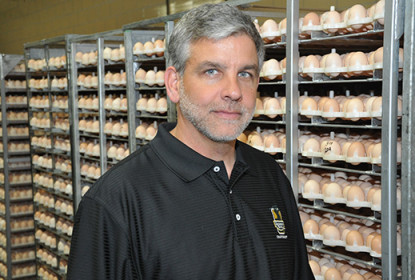
Biosecurity, Expert Advice, Global TOP NEWS, Infectious Diseases, News, PHT GLOBAL, PHT US, Respiratory, TOP NEWS
... Breaches in biosecurity: Sanderson Farms vet shares three valuable lessons
Nov 05, 2015Jennifer GrullonComments Off on Breaches in biosecurity: Sanderson Farms vet shares three valuable lessons
By Philip A. Stayer, DVM Corporate Veterinarian, Sanderson Farms, Inc.... Fine-tuning rotation plan can improve coccidiosis management
Sep 29, 2015Jennifer GrullonComments Off on Fine-tuning rotation plan can improve coccidiosis management
Broiler producers have made important strides in managing coccidiosis but could further improve control and cut losses by rethinking their strategy for anticoccidial rotation, say veterinarians who...... Sustainability: What on earth does it really mean? And how does it apply to poultry health?
Sep 10, 2015Jennifer GrullonComments Off on Sustainability: What on earth does it really mean? And how does it apply to poultry health?
In the poultry industry, sustainability trends are reshaping every link in the production chain. But what exactly does it mean for poultry to be “sustainable”?... Sustainability: What does it mean to poultry health?
Aug 27, 2015Jennifer GrullonComments Off on Sustainability: What does it mean to poultry health?
In agriculture, sustainability translates to producing more with less — a goal that morphs into a dire need when looking at global population trends. According to a recent UN report, food...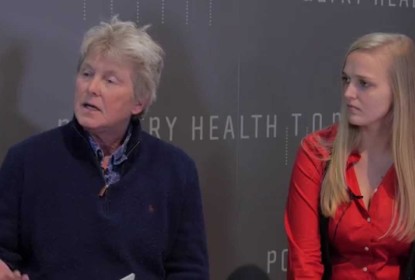
Diagnostics, Global TOP NEWS, Gut Health, ippe2015- Interviews with experts, News, PHT GLOBAL, PHT US, TOP NEWS, Videos
... Coccidiosis research yielding new perspectives on AST
Jul 30, 2015Jennifer GrullonComments Off on Coccidiosis research yielding new perspectives on AST
Adding molecular biology (PCR) to anticoccidial sensitivity testing (AST), offers a more in-depth look — and surprising findings — of Eimeria species contributing to coccidiosis in poultry...
Global TOP NEWS, Infectious Diseases, ippe2015- Interviews with experts, News, PHT GLOBAL, PHT US, TOP NEWS, Videos
... Poultry vet urges poultry producers to guard against E. coli
May 21, 2015Jennifer GrullonComments Off on Poultry vet urges poultry producers to guard against E. coli
Long regarded as a secondary infection to respiratory disease, E. coli is now rated as a primary infection in many layer and broiler-breeder flocks, according to Jose Linares, DVM and technical...... Media consultant: Let poultry vets tell the antibiotic story
May 07, 2015Jennifer GrullonComments Off on Media consultant: Let poultry vets tell the antibiotic story
The U.S. poultry industry needs to do a better job telling its story about antibiotics and their role in sustainable production and flock welfare, according to Frank Singleton, a media consultant...
Antibiotic-free, Global TOP NEWS, Gut Health, ippe2015- Interviews with experts, News, PHT GLOBAL, PHT US, TOP NEWS, Videos
... Poultry specialist offers tips for managing gut health through better nutrition
Apr 30, 2015Jennifer GrullonComments Off on Poultry specialist offers tips for managing gut health through better nutrition
Nutritionist Brett Lumpkins, PhD, of Southern Poultry Research, Athens, Georgia, talks about antibiotic-free poultry production, the challenges it presents and how rations can be adjusted for better...
Global TOP NEWS, ippe2015- Interviews with experts, News, PHT GLOBAL, PHT US, Sustainability, TOP NEWS, Videos
... Defining, and demonstrating, sustainability in the poultry industry
Apr 22, 2015Jennifer GrullonComments Off on Defining, and demonstrating, sustainability in the poultry industry
Billy Hargis, PhD, University of Arkansas, thinks the US poultry industry has already set high standards for sustainability, but its efforts are largely misunderstood and unappreciated.... Broiler chicks show less tendon swelling, weight suppression in reovirus vaccine study
Apr 02, 2015Jennifer GrullonComments Off on Broiler chicks show less tendon swelling, weight suppression in reovirus vaccine study
A recent study showed that broiler chicks receiving higher reovirus antibody levels from conventionally vaccinated hens had a lower incidence of tendon swelling and were protected from weight...... Link between fishmeal, Eimeria and necrotic enteritis in broilers explored
Feb 28, 2015Jennifer GrullonComments Off on Link between fishmeal, Eimeria and necrotic enteritis in broilers explored
Insights into how fishmeal in poultry rations and Eimeria infection may predispose broilers to necrotic enteritis come from a study by Australian investigators.
Antibiotic-free, Global TOP NEWS, Gut Health, ippe2015- Highlights from our latest issue, News, PHT GLOBAL, PHT US, Sustainability, TOP NEWS
... Roundtable highlights: Raising poultry without antibiotics
Jan 27, 2015Jennifer GrullonComments Off on Roundtable highlights: Raising poultry without antibiotics
Antibiotic-free poultry production remains uncharted territory that’s yielding varied results, a few surprises and an ethical dilemma for veterinarians, poultry experts said at an industry...... Doing a 180: A little education goes a long way toward changing customers’ attitudes about antibiotics
Dec 11, 2014Jennifer GrullonComments Off on Doing a 180: A little education goes a long way toward changing customers’ attitudes about antibiotics
Back in 2008, Pfizer Animal Health (now Zoetis Inc.) conducted market research to get a better handle on consumer opinions about the use of antibiotics...... Too busy for sustainability? Think again
Dec 04, 2014Jennifer GrullonComments Off on Too busy for sustainability? Think again
Sure, sustainability is a sound and noble concept — something everyone needs to think about and practice — but try telling that to a veterinarian or producer in the middle of an infectious...


